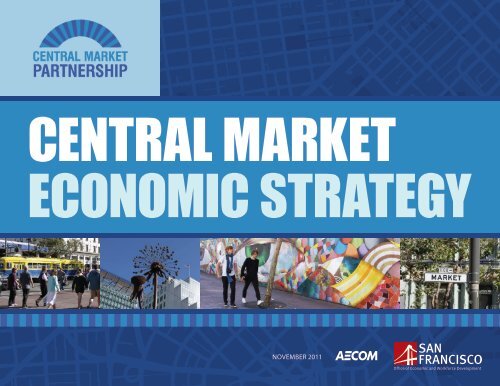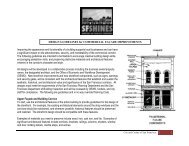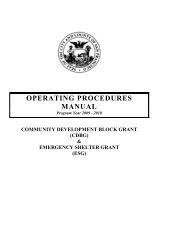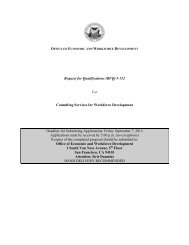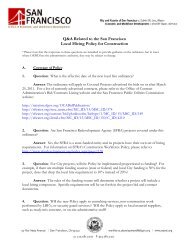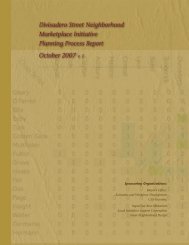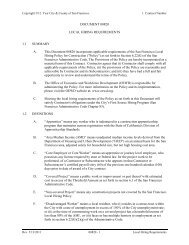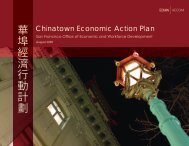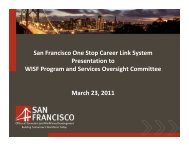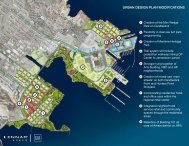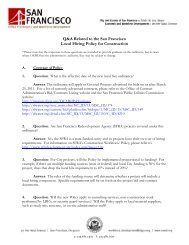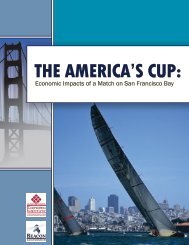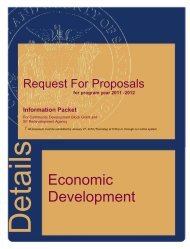NOVEMBER 2011 - Office of Economic and Workforce Development
NOVEMBER 2011 - Office of Economic and Workforce Development
NOVEMBER 2011 - Office of Economic and Workforce Development
Create successful ePaper yourself
Turn your PDF publications into a flip-book with our unique Google optimized e-Paper software.
CENTRAL MARKET<br />
ECONOMIC STRATEGY<br />
<strong>NOVEMBER</strong> <strong>2011</strong>
<strong>Office</strong> <strong>of</strong> the Mayor<br />
<br />
san francisco<br />
EDWIN M. LEE<br />
Mayor<br />
November 30, <strong>2011</strong><br />
Dear Community Members,<br />
Thank you for reading this report, <strong>and</strong> for partnering with us to strengthen Central Market. The Central Market <strong>Economic</strong><br />
Strategy is the culmination <strong>of</strong> over ten months <strong>of</strong> community outreach, technical research, <strong>and</strong> collaboration <strong>of</strong> a diverse<br />
group <strong>of</strong> stakeholders. Please take time to carefully review the action plan presented here, which lays out a vision for the<br />
revitalization <strong>of</strong> the district.<br />
Central Market is key to San Francisco’s future as a vibrant, diverse, <strong>and</strong> economically thriving City. The neighborhood is<br />
at a crossroads: we now have a historic opportunity to restore Central Market to its position as a vital commercial center.<br />
By leveraging our recent successes in the neighborhood <strong>and</strong> building on existing community assets, we can create jobs<br />
<strong>and</strong> increase the quality <strong>of</strong> life for all residents. This document provides a clear road map for the City <strong>and</strong> our partners<br />
that are committed to improving the district.<br />
Central Market will continue to be a top priority for my administration. I have directed City staff <strong>and</strong> department heads<br />
to prioritize the strategies <strong>and</strong> programs identified in this document <strong>and</strong>, to the extent that they are able, incorporate them<br />
into their regular activities <strong>and</strong> budgets. My staff is also working closely with the many stakeholders that are dedicated to<br />
the neighborhood to ensure that our efforts are complementary <strong>and</strong> collaborative. I implore the businesses, foundations,<br />
organizations <strong>and</strong> individuals that care about Central Market to direct their resources <strong>and</strong> energy toward the achievement<br />
<strong>of</strong> the community’s priorities for the neighborhood. By working together, we can achieve the ambitious objectives laid out<br />
in this document <strong>and</strong> ensure that Central Market is a thriving <strong>and</strong> welcoming community for residents, artists, businesses,<br />
visitors, shoppers, <strong>and</strong> all San Franciscans.<br />
Thank you again for your partnership <strong>and</strong> commitment to Central Market. I hope to see you on Market Street!<br />
Sincerely,<br />
Mayor Edwin M. Lee
CENTRAL MARKET<br />
ECONOMIC STRATEGY<br />
<strong>NOVEMBER</strong> <strong>2011</strong>
Contents<br />
1<br />
Introduction 1<br />
4<br />
Central Market Action Plan 29<br />
About the Action Plan 29<br />
Objectives & Strategies 31<br />
2<br />
<strong>Economic</strong> Strategy Overview 5<br />
Strategy Purpose 5<br />
Guiding Principles 5<br />
Geographic Area 6<br />
Methodology <strong>and</strong> Process 8<br />
5<br />
Implementation & Evaluation 37<br />
General Strategies for Implementation ..........................................37<br />
Funding Strategies .................................................................................38<br />
Evaluation & Adjustement ...................................................................39<br />
3<br />
Findings 13<br />
Key Neighborhood Assets 13<br />
Top Concerns <strong>and</strong> Challenges14<br />
Residents 14<br />
Businesses16<br />
Housing 18<br />
Commercial Real Estate 20<br />
Arts & Nonpr<strong>of</strong>it Organizations22<br />
Sidewalk Activity & Safety 24<br />
Arts & Cultural District Case Studies26<br />
6<br />
7<br />
Acknowledgements 41<br />
Appendices 43<br />
Contents<br />
i
What is the Central Market<br />
<strong>Economic</strong> Strategy?<br />
• A thorough community planning<br />
process to prioritize the activities,<br />
programs, <strong>and</strong> policies that will<br />
revitalize Central Market<br />
• A framework for public sector<br />
activities, community-based<br />
organizations’ activities, <strong>and</strong> private &<br />
philanthropic investment
1<br />
Introduction<br />
Central Market—the stretch <strong>of</strong> Market Street between 5th Street <strong>and</strong> Van Ness Avenue also known as Mid-Market—is a<br />
vital segment <strong>of</strong> the urban core <strong>of</strong> the San Francisco Bay Area. For over a century, the district has served as a regional<br />
center for arts, entertainment <strong>and</strong> retail. Over the past several decades, the district has struggled with high vacancy rates,<br />
a lack <strong>of</strong> private investment, physical blight, <strong>and</strong> a myriad <strong>of</strong> social challenges.<br />
In January 2010, then-mayor Gavin Newsom directed the <strong>Office</strong> <strong>of</strong><br />
<strong>Economic</strong> & <strong>Workforce</strong> <strong>Development</strong> (OEWD) to increase efforts to<br />
revitalize Central Market. OEWD launched the Central Market<br />
Partnership, a public/private initiative to strengthen the neighborhood,<br />
increase economic opportunities for residents, improve the selection<br />
<strong>and</strong> quality <strong>of</strong> retail in the neighborhood, <strong>and</strong> restore Central Market<br />
as San Francisco’s downtown arts district. The initiative was launched<br />
as a partnership in acknowledgement <strong>of</strong> the fact that the City cannot<br />
by itself turn around the district; the revitalization <strong>of</strong> the neighborhood<br />
will require a genuine partnership <strong>of</strong> residents, businesses, property<br />
owners, community-based organizations, public sector agencies, arts<br />
groups, <strong>and</strong> other community stakeholders.<br />
Following the launch <strong>of</strong> the Central Market Partnership, a number <strong>of</strong><br />
funders—including the City, National Endowment for the Arts, the<br />
Rainin Foundation, Blick Art Materials, <strong>and</strong> others—invested over $1<br />
million in the neighborhood in 2010-<strong>2011</strong>. Those investments,<br />
combined with an immense amount <strong>of</strong> pro bono work <strong>and</strong> sweat<br />
equity, have yielded some significant successes, including:<br />
• arts programming, such as the UN Plaza Arts Market, the 24<br />
Days <strong>of</strong> Central Market annual festival, Art in Storefronts, Lights<br />
on Market Street installations;<br />
• technical assistance <strong>and</strong> funding to enable the expansion or<br />
attraction <strong>of</strong> arts venues <strong>and</strong> organizations, including the Exit<br />
Theater, Luggage Store Gallery, Gray Area Foundation for the<br />
Arts, Boxcar Studios, Burning Man Headquarters, Film<br />
Commission Film Writing Incubator, Hospitality House<br />
Community Art Program, SF Camerawork, <strong>and</strong> PianoFight;<br />
• attraction <strong>of</strong> small businesses <strong>and</strong> large employers, including<br />
Twitter, Zendesk, Show Dogs, Huckleberry Bicycles, <strong>and</strong> Pearl’s<br />
Deluxe Burgers;<br />
• <strong>and</strong> neighborhood marketing <strong>and</strong> promotional campaigns.<br />
Introduction 1
As OEWD <strong>and</strong> its partners engaged in these activities over the<br />
course <strong>of</strong> 2010, it became apparent that there are dozens <strong>of</strong><br />
organizations <strong>and</strong> countless individuals working to improve <strong>and</strong><br />
strengthen Central Market. However, there was no unifying<br />
framework to guide this work, <strong>and</strong> no clear method to ensure<br />
coordination <strong>and</strong> prevent duplication <strong>of</strong> efforts.<br />
Thus, in early <strong>2011</strong> OEWD launched a community-oriented planning<br />
process to enable neighborhood residents <strong>and</strong> other stakeholders to<br />
prioritize the activities, programs <strong>and</strong> policies that will strengthen<br />
<strong>and</strong> transform the district. This report documents that process <strong>and</strong><br />
presents the resulting action plan, which can serve as a roadmap for<br />
forthcoming efforts to revitalize the district.<br />
2
2 <strong>Economic</strong> Strategy Overview<br />
STRATEGY PURPOSE<br />
The purpose <strong>of</strong> the Central Market <strong>Economic</strong> Strategy is to prioritize the economic development activities to be carried out in the district by<br />
public sector agencies, private sector <strong>and</strong> philanthropic investors, <strong>and</strong> nonpr<strong>of</strong>it organizations. It is a strategic framework that can inform the<br />
work <strong>of</strong> a wide variety <strong>of</strong> stakeholders that are engaged in community <strong>and</strong> economic development, advocacy, grant-making, <strong>and</strong> other activities<br />
affecting Central Market. It identifies objectives <strong>and</strong> strategies that can address the current challenges facing the neighborhood, <strong>and</strong> that have<br />
been designated by residents <strong>and</strong> other stakeholders as the top priorities for action. Additionally, it is an iterative document that will be revised<br />
to reflect stakeholder feedback <strong>and</strong> changing conditions in the neighborhood.<br />
GUIDING PRINCIPLES<br />
Over the course <strong>of</strong> the project, these guiding principles were identified by residents <strong>and</strong> other neighborhood stakeholders as central to any<br />
neighborhood revitalization efforts:<br />
• Promote the development <strong>of</strong> a healthy, economically functional<br />
low-income neighborhood. All San Franciscans deserve a clean,<br />
safe community with access to quality <strong>and</strong> affordable goods <strong>and</strong><br />
services.<br />
• Prevent displacement <strong>of</strong> existing residents <strong>and</strong> businesses.<br />
The long-term residents, businesses, <strong>and</strong> organizations that<br />
currently reside in Central Market should not be threatened by<br />
changes that result from the implementation <strong>of</strong> economic<br />
development activities.<br />
• Create a more economically diverse community. Community<br />
stability <strong>and</strong> economic mobility will follow from the integration <strong>of</strong><br />
economically diverse residents into the neighborhood, including<br />
more families <strong>and</strong> moderate-income households.<br />
• Maximize economic opportunities for everyone. Residents<br />
should have access to jobs <strong>and</strong> career paths, <strong>and</strong> Central Market<br />
should be an environment where small businesses, employers, <strong>and</strong><br />
arts <strong>and</strong> nonpr<strong>of</strong>it organizations are able to thrive.<br />
• Focus on what wouldn’t happen otherwise. The energy <strong>and</strong><br />
resources <strong>of</strong> the City <strong>and</strong> its partners should be directed toward<br />
catalytic activities. Strategies that are likely to be implemented<br />
without intervention should be de-prioritized.<br />
• Prioritize strategies that are implementable <strong>and</strong> sustainable.<br />
The Central Market <strong>Economic</strong> Strategy is aspirational, but should<br />
also be realistic, achievable, <strong>and</strong> fundable.<br />
<strong>Economic</strong> Strategy Overview 5
GEOGRAPHIC AREA<br />
Figure 1 illustrates the geographic areas covered by the Central<br />
Market <strong>Economic</strong> Strategy project. The strategy focus area covers<br />
Market Street between 5th <strong>and</strong> 11th Streets; most <strong>of</strong> the objectives<br />
<strong>and</strong> strategies in the action plan are primarily focused on improving<br />
this segment <strong>of</strong> Market Street. However, the vitality <strong>and</strong> well-being <strong>of</strong><br />
the district are closely linked to the vitality <strong>and</strong> well-being <strong>of</strong> the<br />
adjacent neighborhoods, the Tenderloin <strong>and</strong> northwest SOMA. As<br />
such, several <strong>of</strong> the objectives <strong>and</strong> strategies are relevant to those<br />
neighborhoods, <strong>and</strong> most <strong>of</strong> the demographic data <strong>and</strong> other<br />
research collected for this study is representative <strong>of</strong> the larger study<br />
area indicated in Figure 1 (which includes the adjacent<br />
neighborhoods). The business study area represents the area within<br />
which much <strong>of</strong> the economic <strong>and</strong> commercial data was collected.<br />
6 Central Market <strong>Economic</strong> Strategy
GOUGH<br />
BRADY<br />
COLUSA<br />
11TH<br />
JUNIPER<br />
10TH<br />
GRACE<br />
DORE<br />
WASHBURN<br />
09TH<br />
LASKIE<br />
08TH<br />
RODGERS<br />
LANGTON<br />
07TH<br />
MOSS<br />
SHERMAN<br />
RUSS<br />
HARRIET<br />
06TH<br />
MARY<br />
MINT<br />
05TH<br />
04TH<br />
03RD<br />
FILLMORE<br />
Strategy Focus Area<br />
Business Study Area<br />
WEBSTER<br />
FULTON<br />
Larger Study Area<br />
ELM<br />
LARCH<br />
WILLOW<br />
OLIVE<br />
WILLOW<br />
OLIVE<br />
CEDAR<br />
MYRTLE<br />
MEACHAM<br />
SUTTER<br />
BUSH<br />
PINE<br />
CALIFORNIA<br />
NOB HILL<br />
VINE<br />
SACRAMENTO<br />
PEARL<br />
CLINTON<br />
BUCHANAN<br />
HAIGHT<br />
WALLER<br />
ELGIN<br />
VALENCIA<br />
WOODWARD<br />
LAGUNA<br />
PAGE<br />
OCTAVIA<br />
LILY<br />
MCCOPPIN<br />
STEVENSON<br />
ROSE<br />
LINDEN<br />
OAK<br />
HWY 101 NORTHBOUND<br />
ERIE<br />
PLUM<br />
IVY<br />
GROVE<br />
FELL<br />
OTIS<br />
GOUGH<br />
HAYES<br />
12TH<br />
HICKORY<br />
12TH<br />
SOUTH VAN NESS<br />
LAFAYETTE<br />
FRANKLIN<br />
MINNA<br />
ASH<br />
FULTON<br />
BURNS<br />
NATOMA<br />
KISSLING<br />
REDWOOD<br />
VAN NESS<br />
Bill Graham<br />
STEVENSON<br />
JESSIE<br />
GOLDEN GATE<br />
MCALLISTER<br />
POLK<br />
ELM<br />
REDWOOD<br />
TEHAMA<br />
CLEMENTINA<br />
POLK<br />
TURK<br />
UN Plaza<br />
SUMNER<br />
LARKIN<br />
DODGE<br />
MARKET<br />
NATOMA<br />
RAUSCH<br />
EDDY<br />
HYDE<br />
Renoir Hotel<br />
STEVENSON<br />
COHEN<br />
MISSION<br />
ADA<br />
Hibernia Bank<br />
TULIP<br />
MINNA<br />
HOWARD<br />
FOLSOM<br />
ANTONIO<br />
LEAVENWORTH<br />
OPAL<br />
JONES<br />
TEHAMA<br />
TAYLOR<br />
CLEMENTINA<br />
COLIN<br />
GEARY<br />
HOBART<br />
COSMO<br />
POST<br />
Taylor Street Arts<br />
Golden Gate<br />
JESSIE<br />
ELLIS<br />
JESSIE<br />
DERBY DERBY<br />
CYRIL MAGNIN<br />
JESSIE<br />
MASON<br />
HOOKER<br />
Hallidie Plaza<br />
Chronicle Building<br />
POWELL<br />
ANSON<br />
MAIDEN<br />
STOCKTON<br />
BURRITT<br />
CAMPTON<br />
GRANT<br />
STEVENSON<br />
FALMOUTH<br />
15TH<br />
NATOMA<br />
14TH<br />
ERIE<br />
ISIS<br />
SHERIDAN<br />
RINGOLD<br />
SHIPLEY<br />
CLARA<br />
BONIFACIO<br />
RIZAL<br />
NORFOLK<br />
HALLAM<br />
Central Market Cultural District Strategy: Focus Area <strong>and</strong> Study Area<br />
Figure 1. Geographic Areas<br />
<strong>Economic</strong> Strategy Overview 7
METHODOLOGY AND PROCESS<br />
Beginning in January <strong>2011</strong>, a team <strong>of</strong> OEWD staff, paid <strong>and</strong> pro-bono consultants, interns, <strong>and</strong> volunteers (‘project staff’) conducted a wide<br />
variety <strong>of</strong> activities as part <strong>of</strong> the Central Market <strong>Economic</strong> Strategy, outlined below.<br />
Starting Point<br />
In January <strong>2011</strong>, OEWD kicked <strong>of</strong>f the project by developing a scope<br />
<strong>of</strong> work, schedule, <strong>and</strong> list <strong>of</strong> stakeholders to be engaged throughout<br />
the project. The process was intended to:<br />
• build on the momentum <strong>and</strong> interest developed by previous efforts;<br />
• gather, review, <strong>and</strong> analyze data regarding the project area for use<br />
in developing strategies to stabilize <strong>and</strong> revitalize the area;<br />
• <strong>and</strong> launch a widespread community engagement effort for the<br />
purpose <strong>of</strong> refining strategies, <strong>and</strong> prioritizing the most critical<br />
improvements for the district.<br />
The development <strong>of</strong> the Central Market <strong>Economic</strong> Strategy was an<br />
iterative process. Continuous input from the community, combined<br />
with a technical review <strong>and</strong> analysis <strong>of</strong> existing physical, economic,<br />
<strong>and</strong> social conditions, together formed the basis for this <strong>Economic</strong><br />
Strategy. This is a “living document” – meaning that it will be reviewed<br />
<strong>and</strong> updated periodically by OEWD <strong>and</strong> partner agencies, to indicate<br />
the status <strong>of</strong> the strategies, a reordering or priorities, or a reallocation<br />
or resources.<br />
Public Meetings <strong>and</strong> Forums<br />
Project Planning<br />
Background Research<br />
Merchant Survey<br />
Intercept Survey<br />
Resident Survey<br />
Focus Groups<br />
Interviews<br />
Drafts <strong>and</strong> Revisions<br />
January February March April May June July August September October<br />
Figure 2. Project Timeline<br />
8 Central Market <strong>Economic</strong> Strategy
Initial Phase:<br />
Review Past <strong>and</strong><br />
Current Efforts<br />
<strong>Development</strong> <strong>and</strong><br />
Refinement<br />
Phase<br />
Implementation<br />
Phase<br />
Figure 3. Project Design<br />
<strong>Economic</strong> Strategy Overview 9
Community Engagement<br />
A robust community engagement effort was the cornerstone <strong>of</strong> the<br />
Central Market <strong>Economic</strong> Strategy process. Over the course <strong>of</strong> ten<br />
months (January - October <strong>2011</strong>), project staff conducted four public<br />
meetings, three surveys, eleven focus groups, eighteen interviews,<br />
<strong>and</strong> through these activities spoke with nearly seven hundred people<br />
about Central Market. The complete process is outlined here:<br />
• Steering Committee. On seven occasions between January <strong>and</strong><br />
October, OEWD convened a steering committee comprised <strong>of</strong><br />
project team members, representatives from public <strong>and</strong> nonpr<strong>of</strong>it<br />
agencies that are actively involved in revitalization <strong>of</strong> the Central<br />
Market, <strong>and</strong> other interested community stakeholders. The steering<br />
committee acted as an informal advisory board, providing<br />
guidance, oversight, review, <strong>and</strong> feedback on the process <strong>and</strong><br />
content <strong>of</strong> the project at each stage. Over time, the steering<br />
committee exp<strong>and</strong>ed to include more interested stakeholders.<br />
• Community Meetings. OEWD <strong>and</strong> the San Francisco<br />
Redevelopment Agency (SFRA) convened a series <strong>of</strong> four Central<br />
Market Partnership meetings to share information, facilitate<br />
discussion, <strong>and</strong> gather feedback on each stage <strong>of</strong> the project. The<br />
topics <strong>of</strong> presentation <strong>and</strong> discussion included the project goal <strong>and</strong><br />
process, research findings, attendees’ general feelings <strong>and</strong><br />
opinions about the neighborhood, <strong>and</strong> prioritization <strong>of</strong> economic<br />
development strategies. Meeting attendance was typically between<br />
40 <strong>and</strong> 50 people; attendees included residents, workers,<br />
merchants, nonpr<strong>of</strong>it organizations, artists <strong>and</strong> arts organizations,<br />
property owners, <strong>and</strong> other stakeholders.<br />
• Merchant Survey. A team <strong>of</strong> graduate students at the UC Berkeley<br />
Department <strong>of</strong> City & Regional Planning conducted short interviews<br />
with a representative sample <strong>of</strong> 20 merchants in the district. See<br />
Appendix 2 for the full text <strong>and</strong> analysis <strong>of</strong> the survey.<br />
• Resident Survey. OEWD, in partnership with community housing<br />
organizations <strong>and</strong> other community groups, conducted a survey <strong>of</strong><br />
residents <strong>of</strong> Central Market <strong>and</strong> adjacent neighborhoods (124<br />
respondents). See Appendix 3 for the full text <strong>and</strong> analysis <strong>of</strong> the<br />
survey.<br />
• Intercept Survey. A team <strong>of</strong> UC Berkeley students conducted a<br />
survey <strong>of</strong> people on the street in Central Market (385 respondents).<br />
See Appendix 4 for the full text <strong>and</strong> analysis <strong>of</strong> the survey.<br />
• Focus Groups. In June <strong>and</strong> July project staff facilitated 11 focus<br />
groups with approximately 110 total participants. Focus groups<br />
were generally organized by stakeholder category, including arts<br />
groups, l<strong>and</strong> use <strong>and</strong> economic development organizations,<br />
housing <strong>and</strong> human services organizations, merchants, residents,<br />
property owners, historic preservation advocates, city staff, <strong>and</strong><br />
one final ‘catch-all’ focus group for any interested party.<br />
• Interviews. Project staff conducted 18 interviews with residents,<br />
community advocates, housing <strong>and</strong> economic development<br />
pr<strong>of</strong>essionals, employers, foundation staff, <strong>and</strong> other key<br />
stakeholders.<br />
• Central Market / Tenderloin Area Citizens Advisory Committee<br />
(CAC). In October <strong>2011</strong>, OEWD staff made two presentations to the<br />
newly-formed CAC to discuss the project <strong>and</strong> gather feedback that<br />
contributed to revisions <strong>of</strong> the draft strategy.<br />
• E-mail List. OEWD maintains an e-mail list (approximately 600<br />
subscribers as <strong>of</strong> October <strong>2011</strong>) <strong>of</strong> neighborhood stakeholders.<br />
Throughout the process it was used as one <strong>of</strong> several methods <strong>of</strong><br />
communication regarding neighborhood events, surveys, etc.<br />
• Other Meetings <strong>and</strong> Outreach. Project staff conducted over 20<br />
additional meetings <strong>and</strong> presentations at various venues to discuss<br />
the project <strong>and</strong> gather information <strong>and</strong> feedback from a variety <strong>of</strong><br />
stakeholders.<br />
• Website. In August <strong>2011</strong>, OEWD, SFRA, <strong>and</strong> the design firm Words<br />
Pictures Ideas launched www.centralmarketpartnership.org to<br />
promote the district, document the economic strategy project, <strong>and</strong><br />
gather community feedback.<br />
See Appendix 1 for a matrix <strong>of</strong> agencies <strong>and</strong> individuals that participated in<br />
the various community engagement activities.<br />
10 Central Market <strong>Economic</strong> Strategy
Background Research, Data Collection <strong>and</strong> Analysis<br />
Project staff collected <strong>and</strong> reviewed nearly 70 primary <strong>and</strong> secondary<br />
sources <strong>of</strong> information relating to demographics, the arts, business<br />
<strong>and</strong> economic activity, real estate, health <strong>and</strong> human services,<br />
housing, planning, tourism <strong>and</strong> transportation. Primary data sources<br />
included, for example, an inventory <strong>of</strong> businesses in the district;<br />
analysis <strong>of</strong> sales tax trends; collection <strong>and</strong> analysis <strong>of</strong> parking<br />
capacity <strong>and</strong> occupancy data; <strong>and</strong> an analysis <strong>of</strong> the provision <strong>of</strong><br />
social services in the neighborhood. Secondary sources included<br />
past community surveys, studies, <strong>and</strong> plans; environmental impact<br />
reports for relevant projects; real estate data from brokers <strong>and</strong> firms;<br />
articles about the neighborhood from newspapers, magazines, <strong>and</strong><br />
journals; legislation specifically relevant to the district; <strong>and</strong> other<br />
research. In addition to this research, a project consultant conducted<br />
case studies <strong>of</strong> arts <strong>and</strong> cultural districts around the nation to identify<br />
best practices that are relevant to Central Market. For a complete list<br />
<strong>of</strong> research <strong>and</strong> data sources, see Appendix 5.<br />
Drafts <strong>and</strong> Revisions<br />
Findings <strong>and</strong> information from community engagement <strong>and</strong> research<br />
were released periodically throughout the project, via public<br />
meetings, steering committee meetings, <strong>and</strong> dissemination via e-mail<br />
<strong>and</strong> the Internet. The matrix <strong>of</strong> objectives <strong>and</strong> strategies (Section 5 <strong>of</strong><br />
this report) went through three public iterations <strong>of</strong> draft <strong>and</strong> revisions.<br />
Each iteration included steering committee <strong>and</strong> public meetings to<br />
review <strong>and</strong> discuss the draft; to gather feedback regarding necessary<br />
edits, additions, <strong>and</strong> deletions; <strong>and</strong> to identify which elements are the<br />
highest priority. In September <strong>and</strong> October <strong>2011</strong> the project team<br />
conducted prioritization exercises—including small group<br />
discussions, a written survey, <strong>and</strong> a web-based survey—whereby<br />
residents <strong>and</strong> other stakeholders were asked to choose their top 5<br />
priorities; the results <strong>of</strong> that exercise (with approximately 150<br />
participants) helped to inform the prioritization <strong>of</strong> items in the<br />
subsequent drafts.<br />
<strong>Economic</strong> Strategy Overview 11
3 Findings<br />
Through the community engagement <strong>and</strong> research described above, the project team gathered a great deal <strong>of</strong><br />
information about the neighborhood, including quantitative <strong>and</strong> qualitative data, distinctive characteristics <strong>of</strong> Central<br />
Market, <strong>and</strong> a broad range <strong>of</strong> opinions regarding the neighborhood’s strengths <strong>and</strong> challenges. The key findings are<br />
presented below.<br />
KEY NEIGHBORHOOD ASSETS<br />
Early on, through direct research <strong>and</strong> community engagement, the project team identified a number <strong>of</strong> neighborhood assets that contribute to<br />
the health <strong>and</strong> vitality <strong>of</strong> the neighborhood. These include:<br />
• Central location. Central Market is centrally located within the City<br />
<strong>and</strong> region, adjacent to other thriving <strong>and</strong> diverse neighborhoods<br />
<strong>and</strong> commercial districts (e.g., SOMA, Tenderloin, Civic Center).<br />
• Transit access. The neighborhood is directly served by several<br />
MUNI lines, BART, <strong>and</strong> Golden Gate Transit, <strong>and</strong> is within<br />
reasonable distance to AC Transit, SamTrans <strong>and</strong> CalTrain.<br />
• Diverse population. The population is reflective <strong>of</strong> San Francisco’s<br />
overall population in that it is racially <strong>and</strong> ethnically diverse. In<br />
particular, Central Market <strong>and</strong> the adjacent neighborhoods have<br />
historically been home to a number <strong>of</strong> communities <strong>of</strong> people <strong>of</strong><br />
Southeast Asian origin.<br />
• Vibrant arts <strong>and</strong> cultural community. The neighborhood has<br />
historically been home to a variety <strong>of</strong> arts organizations, including<br />
small <strong>and</strong> large theaters, galleries, rehearsal spaces, <strong>and</strong><br />
headquarters. Over the past two years, arts entities have<br />
increasingly expressed interest in relocating to the district.<br />
• Housing affordability. A large percentage <strong>of</strong> the housing stock in the<br />
neighborhood is affordable—developed as permanently affordable<br />
housing, or as residential hotels—providing a crucial resource for<br />
people who would otherwise be unable to secure housing in San<br />
Francisco.<br />
• Strong nonpr<strong>of</strong>it infrastructure. Dozens <strong>of</strong> nonpr<strong>of</strong>it agencies,<br />
including several <strong>of</strong> the City’s leading service providers, are<br />
headquartered <strong>and</strong>/or have service sites within the district.<br />
• Plazas <strong>and</strong> public spaces. The neighborhood features several large<br />
public spaces (including Civic Center Plaza, UN Plaza, Hallidie<br />
Plaza, Mint Plaza, <strong>and</strong> the Federal Building Plaza) that can be<br />
utilized for leisure, arts <strong>and</strong> performances, commercial activities,<br />
<strong>and</strong> public gathering.<br />
Findings 13
TOP CONCERNS AND CHALLENGES<br />
Residents, merchants, workers, <strong>and</strong> other stakeholders most<br />
frequently cited these items as their top concerns about the<br />
neighborhood:<br />
• Public Safety. Stakeholders reported feeling unsafe in the<br />
neighborhood, <strong>and</strong> concern about the high level <strong>of</strong> criminal activity.<br />
• Vacant Storefronts. Central Market suffers from higher vacancy<br />
rates than any other commercial corridor in San Francisco:<br />
approximately 30% for retail storefronts, <strong>and</strong> 50% for <strong>of</strong>fice space.<br />
• Cleanliness. Community members cited graffiti <strong>and</strong> poor upkeep <strong>of</strong><br />
the sidewalks as negative impacts on their experience in Central<br />
Market.<br />
• Homelessness. Homelessness was one <strong>of</strong> the top concerns cited<br />
by community members, especially area residents <strong>and</strong> merchants.<br />
When listing their top concerns, stakeholders may have cited<br />
‘cleanliness’ <strong>and</strong> ‘homelessness’ as proxies for negative behaviors in<br />
the public realm, such as aggressive panh<strong>and</strong>ling, public urination<br />
<strong>and</strong> defecation, <strong>and</strong> criminal behavior (e.g., drug dealing). Observers<br />
frequently misperceive the people engaging in these street activities<br />
to be homeless, whereas many <strong>of</strong> the people engaging in these<br />
activities in Central Market actually live in the neighborhood, in other<br />
neighborhoods, or other jurisdictions.<br />
RESIDENTS<br />
There are nearly 39,000 residents in the study area, <strong>and</strong> the<br />
demographics <strong>of</strong> the area differ from the City overall in a number <strong>of</strong><br />
ways, as highlighted in figure 4. Compared with the City overall, the<br />
average household size in the study area is considerably smaller, there<br />
are fewer family households, <strong>and</strong> a greater percentage <strong>of</strong> the<br />
population is male. A lower percentage <strong>of</strong> the population in the study<br />
area is participating in the labor force. The percentage <strong>of</strong> households<br />
with income less than $15,000 is 31%, which is more than three times<br />
the City average. In some areas within the district, more than half <strong>of</strong> the<br />
population is living in extreme poverty, as demonstrated in figure 5.<br />
OEWD, in partnership with local housing organizations <strong>and</strong><br />
neighborhood groups, conducted a survey <strong>of</strong> residents during June<br />
<strong>and</strong> July, <strong>2011</strong> 1 . When asked what they liked most about the<br />
neighborhood, residents most frequently cited the location,<br />
accessibility, <strong>and</strong> local social services. Top concerns included<br />
homelessness, dirtiness <strong>of</strong> area, lack <strong>of</strong> public amenities, <strong>and</strong> that<br />
they feel unsafe in the neighborhood. When asked about their desired<br />
improvements for the neighborhood, residents asked for cleaner<br />
streets, safe public spaces, improved public safety, <strong>and</strong> more<br />
housing, both affordable <strong>and</strong> market rate.<br />
Residents were also surveyed regarding their opinions about local<br />
businesses, economic development, <strong>and</strong> the arts. Survey<br />
respondents frequently referenced the need for a full-service grocery<br />
store, a greater variety <strong>of</strong> retail <strong>and</strong> more restaurants. Increased<br />
employment opportunities are a high priority, particularly jobs for<br />
disadvantaged populations. When asked what type <strong>of</strong> arts<br />
programming they would prefer, residents cited displays <strong>of</strong> visual<br />
arts, public performances <strong>and</strong> festivals, <strong>and</strong> community-oriented<br />
programming.<br />
1<br />
See Appendix 3 for the complete text <strong>and</strong> analysis <strong>of</strong> the resident survey.<br />
14 Central Market <strong>Economic</strong> Strategy
GOUGH<br />
BRADY<br />
SUMNER<br />
KATE<br />
JULIA<br />
RAUSCH<br />
HALLAM<br />
RUSS<br />
MORRIS<br />
OAK GROVE<br />
MINT<br />
03RD<br />
ANNIE<br />
HAWTHORNE<br />
Study Area<br />
San Francisco<br />
Figure 4. Demographics, Study Area <strong>and</strong> San Francisco<br />
MYRTLE<br />
HEMLOCK<br />
PIERCE<br />
STEINER<br />
FILLMORE<br />
LAUSSAT<br />
WALLER<br />
GERMANIA<br />
HERMANN<br />
HAIGHT<br />
LAUSSAT<br />
BUCHANAN<br />
MCALLISTER<br />
FULTON<br />
BIRCH<br />
GROVE<br />
IVY<br />
HAYES<br />
LINDEN<br />
FELL<br />
OAK<br />
PAGE<br />
LAGUNA<br />
LILY<br />
ROSE<br />
WALLER<br />
OCTAVIA<br />
WEBSTER<br />
HICKORY<br />
GOUGH<br />
ELM<br />
ASH<br />
FRANKLIN<br />
VAN NESS<br />
POLK<br />
LARCH<br />
WILLOW<br />
REDWOOD<br />
OLIVE<br />
ELM<br />
TURK<br />
LARKIN<br />
BREEN<br />
HYDE<br />
OLIVE<br />
WILLOW<br />
EDDY<br />
CEDAR<br />
FULTON<br />
DODGE<br />
POLK<br />
MYRTLE<br />
DALE<br />
ELLIS<br />
GEARY<br />
ANTONIO<br />
GOLDEN GATE<br />
COHEN<br />
ADA<br />
JONES<br />
LEAVENWORTH<br />
OPAL<br />
COLIN<br />
SUTTER<br />
POST<br />
DERBY<br />
TAYLOR<br />
MASON<br />
CALIFORNIA<br />
PINE<br />
BUSH<br />
OFARRELL<br />
HOOKER<br />
POWELL<br />
CLAY<br />
SACRAMENTO<br />
ANSON<br />
EWER<br />
FELLA<br />
CAMPTON<br />
EMMA<br />
MAIDEN<br />
JOICE<br />
STOCKTON<br />
MILLER<br />
HARLAN<br />
KEARNY<br />
SABIN<br />
GRANT<br />
RAMONA<br />
GUERRERO<br />
VALENCIA<br />
ALBION<br />
CLARION<br />
DOLORES<br />
RONDEL<br />
CAPP<br />
CLINTON<br />
HOFF<br />
16TH<br />
17TH<br />
18TH<br />
CALEDONIA<br />
JULIAN<br />
WIESE<br />
PEARL<br />
ELGIN<br />
DUBOCE<br />
BROSNAN<br />
CLINTON<br />
15TH<br />
14TH<br />
STEVENSON<br />
CAPP<br />
ADAIR<br />
SHOTWELL<br />
MINNA<br />
NATOMA<br />
MCCOPPIN<br />
HWY 101 NORTHBOUND<br />
ERIE<br />
TREAT<br />
PLUM<br />
ERIE<br />
OTIS<br />
ALABAMA<br />
12TH<br />
ISIS<br />
FLORIDA<br />
SOUTH VAN NESS<br />
KISSLING<br />
12TH<br />
ALAMEDA<br />
LAFAYETTE<br />
BERNICE<br />
BRYANT<br />
NORFOLK<br />
13TH<br />
11TH<br />
DIVISION<br />
JUNIPER<br />
ALAMEDA<br />
MINNA<br />
NATOMA<br />
MARKET<br />
STEVENSON<br />
10TH<br />
GRACE<br />
DORE<br />
WASHBURN<br />
SHERIDAN<br />
DORE<br />
DIVISION<br />
JESSIE<br />
09TH<br />
LASKIE<br />
06TH<br />
TEHAMA<br />
CLEMENTINA<br />
RINGOLD<br />
CONVERSE<br />
08TH<br />
HERON<br />
LANGTON<br />
STEVENSON<br />
NATOMA<br />
07TH<br />
I-80 W OFF<br />
ELDRIDGE<br />
LANGTON<br />
MOSS<br />
SHERMAN<br />
I-80 E ON<br />
GILBERT<br />
BOARDMAN<br />
MINNA<br />
HARRIET<br />
HOWARD<br />
FOLSOM<br />
HARRISON<br />
AHERN<br />
JESSIE<br />
MARY<br />
TEHAMA<br />
CLEMENTINA<br />
MERLIN<br />
05TH<br />
CLARA<br />
I-80 W ON<br />
I-80 E OFF<br />
BRYANT<br />
WELSH<br />
BRANNAN<br />
JESSIE<br />
MISSION<br />
04TH<br />
KAPLAN<br />
SHIPLEY BONIFACIO<br />
PERRY<br />
I-80 EASTBOUND<br />
WELSH<br />
FREELON<br />
RIZAL<br />
ZOE<br />
RITCH<br />
MINNA<br />
HUNT<br />
0.0% - 4.0%<br />
4.1% - 25.3%<br />
I-80 WESTBOUND<br />
25.4% - 38.9%<br />
TABER<br />
39.0% - 52.2%<br />
NEW MONTGOMERY<br />
SOUTH PARK<br />
VARNEY<br />
52.3% - 78.9%<br />
Figure Central 5. Market Percentage <strong>of</strong> Households Earning $15,000 or Less<br />
Percent <strong>of</strong> households earning $15,000 or less<br />
I<br />
0 500 1,000 2,000 Feet<br />
Source: 2005-2009 American Community Survey Block Groups<br />
Findings 15
BUSINESSES<br />
The project team partnered with graduate students at UC Berkeley’s<br />
Department <strong>of</strong> City & Regional Planning to study the businesses in<br />
the district. This research included an analysis <strong>of</strong> employment <strong>and</strong><br />
business data <strong>and</strong> trends; an inventory <strong>of</strong> all observable businesses,<br />
organizations <strong>and</strong> non-public institutions in the business study area;<br />
<strong>and</strong> a survey <strong>of</strong> a representative sample <strong>of</strong> twenty merchants,<br />
conducted via in-person interviews.<br />
Industry<br />
Jobs<br />
1991 2000 2008<br />
Arts, Entertainment <strong>and</strong> Recreation 85 116 150<br />
Information 1,593 2,635 1,606<br />
Finance <strong>and</strong> Insurance 1,306 1,118 1,204<br />
Pr<strong>of</strong>essional, Scientific & Technical Services 496 675 1,390<br />
Public Administration 292 893 1,830<br />
Retail 159 588 661<br />
Table 1. Employment Trends By Industry, 1991-2008<br />
Source: UC Berkeley Analysis <strong>of</strong> Dun & Bradstreet NETS Dataset<br />
Project staff had access to localized job data only through 2008.<br />
OEWD business development staff reported evidence <strong>of</strong> these recent<br />
trends (2008-<strong>2011</strong>) in Central Market:<br />
• Growth <strong>of</strong> institutional employers, including education <strong>and</strong> health<br />
care;<br />
• Rebound <strong>of</strong> the technology <strong>and</strong> retail sectors;<br />
• <strong>and</strong> stagnant growth in the finance <strong>and</strong> insurance sectors, <strong>and</strong><br />
other pr<strong>of</strong>essional services.<br />
OEWD compared the Central Market business inventory with similar<br />
studies conducted in different commercial districts in San Francisco<br />
(Bayview, Bernal Heights, Excelsior, Inner Richmond) <strong>and</strong> Oakl<strong>and</strong><br />
(Fruitvale, Lakeshore, Temescal). By comparison, Central Market<br />
features a higher percentage <strong>of</strong> liquor stores, used/thrift/discount<br />
stores (including pawn shops), <strong>and</strong> clothing stores, as illustrated in<br />
figure 6. The comparison also demonstrated Central Market has<br />
relatively fewer service business (e.g., dry cleaning, banking, personal<br />
services).<br />
Table 1 demonstrates that, as <strong>of</strong> 2008, the largest sources <strong>of</strong><br />
employment within the district were the information, finance <strong>and</strong><br />
insurance, pr<strong>of</strong>essional services, <strong>and</strong> public administration sectors.<br />
Finance <strong>and</strong> insurance employment has remained steady since 1991;<br />
information technology spiked upwards in 2000, then returned closer<br />
to 1991 levels by 2008. From 2000 to 2008, employment in<br />
pr<strong>of</strong>essional services <strong>and</strong> public administration experienced large<br />
growth. Similar trends are demonstrated by sales data during the<br />
same period.<br />
Figure 6. Retail Comparison, Central Market <strong>and</strong> Other Bay Area Commercial Corridors<br />
16 Central Market <strong>Economic</strong> Strategy
Findings from the merchant survey 2 include the following:<br />
• Vacancies were cited as the most important issue affecting<br />
business. One merchant stated, “The vacant buildings make the<br />
area seem run-down. There would be more activity with businesses<br />
along the street.”<br />
• When asked to identify disadvantages to locating in the<br />
neighborhood, the merchants’ top responses were the homeless<br />
<strong>and</strong> transient population, <strong>and</strong> lack <strong>of</strong> public safety.<br />
• Several respondents noted the relationship between retail hours <strong>of</strong><br />
operation, customer presence, <strong>and</strong> sense <strong>of</strong> safety. One<br />
respondent said that there is little business in the evening,<br />
specifically after 8pm, as retail stores close early because<br />
customers feel unsafe. Most felt that the area was safest during the<br />
daylight, noting that business was best around lunchtime, especially<br />
for restaurants. Seven respondents mentioned that the sense <strong>of</strong><br />
safety in the neighborhood is directly correlated with the hours that<br />
businesses are open.<br />
• Many respondents noted strong transit access as a great benefit to<br />
Central Market. While some said parking should be more available,<br />
many others explicitly said that parking is not a problem, describing<br />
the area as very accessible <strong>and</strong> the parking supply as sufficient.<br />
Regardless <strong>of</strong> their position on parking, most respondents felt that<br />
transit accessibility was a benefit to their business.<br />
• Many businesses expressed a belief that they benefited from the<br />
“destination” sites in the area, specifically noting improved visitation<br />
during tourist season <strong>and</strong> when nearby theaters <strong>of</strong>fer steady<br />
performances.<br />
• 19 <strong>of</strong> 20 respondents felt that arts expansion would improve<br />
business. One respondent said, “we benefit from the arts, cultural<br />
businesses, restaurants, <strong>and</strong> really just anything that makes people<br />
stop.”<br />
2<br />
See Appendix 2 for the complete text <strong>and</strong> analysis <strong>of</strong> the merchant survey<br />
conducted by the UC Berkeley team.<br />
Findings 17
HOUSING<br />
According to the 2010 Census, there are 21,462 housing units in the<br />
study area. There is a high concentration <strong>of</strong> housing in the study area;<br />
at 49.3 dwelling units per acre, residential density is over four times<br />
the rate <strong>of</strong> San Francisco overall. A high percentage <strong>of</strong> the units in the<br />
study area are occupied by renters: 87%, compared with 61% for the<br />
City overall. Approximately 40% <strong>of</strong> the units in the study area are<br />
permanently affordable housing units.<br />
There is also a high concentration <strong>of</strong> residential hotels (also known as<br />
single-room occupancy hotels, or SROs) in the study area, as<br />
demonstrated in figure 8. Approximately 31% <strong>of</strong> the City’s residential<br />
hotels, including 51% <strong>of</strong> total SRO rooms, are located within the study<br />
area. Figure 9 demonstrates the percentage <strong>of</strong> housing units by block<br />
group that are single-room; in many area <strong>of</strong> Central Market the<br />
average is over 50%, compared to a Citywide average <strong>of</strong> 10%.<br />
Residential hotels are an important resource for the City; they provide<br />
access to low-cost housing for people who are otherwise unable to<br />
secure housing, including people with very low or no income, ex<strong>of</strong>fenders,<br />
people with behavioral health problems, <strong>and</strong> people who<br />
are recently homeless. Yet many residential hotels are very old<br />
buildings (typically constructed over eighty years ago) <strong>and</strong> are <strong>of</strong>ten<br />
in poor condition, with limited accessibility, <strong>and</strong> are unlikely to survive<br />
a major earthquake.<br />
Figure 7. Affordable Housing Units in San Francisco<br />
Source: Mayor’s <strong>Office</strong> <strong>of</strong> Housing<br />
Many affordable housing <strong>and</strong> SRO units are subsidized by various<br />
Department <strong>of</strong> Public Health <strong>and</strong> Human Service Agency housing<br />
programs, which serve people who are recently homeless, people<br />
with behavioral health diagnoses, <strong>and</strong> other vulnerable populations.<br />
There are 5,593 such supported housing units located in the study<br />
area, representing over 90% <strong>of</strong> these units citywide.<br />
A notable amount <strong>of</strong> market rate housing has been constructed in the<br />
neighborhood over the past several years. Two projects completed in<br />
2008—the SOMA Gr<strong>and</strong> <strong>and</strong> the Argenta—included 425 new housing<br />
units. Additional projects slated for development over the next five<br />
years will result in over 3,000 new housing units in the neighborhood.<br />
I<br />
SROs in San Francisco<br />
August <strong>2011</strong><br />
Figure 8. Residential Hotel Distribution<br />
SRO<br />
Central Market<br />
Study Area<br />
1 Mile<br />
Data Source: San Francisco Planning Department<br />
18 Central Market <strong>Economic</strong> Strategy
GOUGH<br />
BRADY<br />
SUMNER<br />
KATE<br />
RAUSCH<br />
HALLAM<br />
RUSS<br />
HARRIET<br />
MORRIS<br />
OAK GROVE<br />
MINT<br />
03RD<br />
ANNIE<br />
HAWTHORNE<br />
MYRTLE<br />
HEMLOCK<br />
SACRAMENTO<br />
PIERCE<br />
HAIGHT<br />
LAUSSAT LAUSSAT<br />
WALLER<br />
GERMANIA<br />
HERMANN<br />
CLARION<br />
DOLORES<br />
RAMONA<br />
CAPP<br />
STEINER<br />
GUERRERO<br />
ALBION<br />
RONDEL<br />
CLINTON<br />
HOFF<br />
18TH<br />
FILLMORE<br />
BUCHANAN<br />
VALENCIA<br />
CALEDONIA<br />
17TH<br />
DUBOCE<br />
BROSNAN<br />
JULIAN<br />
WIESE<br />
CLINTON<br />
15TH<br />
ADAIR<br />
16TH<br />
PAGE<br />
14TH<br />
OAK<br />
WALLER<br />
PEARL<br />
ELGIN<br />
STEVENSON<br />
CAPP<br />
MINNA<br />
SHOTWELL<br />
LAGUNA<br />
NATOMA<br />
FULTON<br />
BIRCH<br />
GROVE<br />
IVY<br />
HAYES<br />
LINDEN<br />
FELL<br />
WEBSTER<br />
TREAT<br />
LILY<br />
OCTAVIA<br />
MCCOPPIN<br />
ROSE<br />
HWY 101 NORTHBOUND<br />
ERIE<br />
PLUM<br />
ERIE<br />
OTIS<br />
ALABAMA<br />
7.8%<br />
MCALLISTER<br />
12TH<br />
GOUGH<br />
HICKORY<br />
12TH<br />
FLORIDA<br />
ISIS<br />
ALAMEDA<br />
SOUTH VAN NESS<br />
LAFAYETTE<br />
KISSLING<br />
BERNICE<br />
13TH<br />
BRYANT<br />
NORFOLK<br />
ASH<br />
11TH<br />
DIVISION<br />
ALAMEDA<br />
FRANKLIN<br />
10TH<br />
30.8%<br />
EDDY<br />
ELM<br />
GOLDEN GATE<br />
REDWOOD<br />
MINNA<br />
NATOMA<br />
JUNIPER<br />
VAN NESS<br />
POLK<br />
54%<br />
15.2%<br />
DORE<br />
DIVISION<br />
JESSIE<br />
GRACE<br />
WASHBURN<br />
DORE<br />
SHERIDAN<br />
09TH<br />
LARCH<br />
LASKIE<br />
ELM<br />
RINGOLD<br />
CONVERSE<br />
OLIVE<br />
TEHAMA<br />
WILLOW<br />
POLK<br />
LARKIN<br />
08TH<br />
39.4%<br />
62.4%<br />
HYDE<br />
40%<br />
CLEMENTINA<br />
BREEN<br />
HERON<br />
OLIVE<br />
MARKET<br />
43.1%<br />
40.8%<br />
LANGTON<br />
CEDAR<br />
07TH<br />
I-80 W OFF<br />
ELDRIDGE<br />
LANGTON<br />
DALE<br />
67%<br />
NATOMA<br />
26%<br />
39.9%<br />
STEVENSON<br />
MOSS<br />
I-80 E ON<br />
GILBERT<br />
18.3%<br />
SHERMAN<br />
BOARDMAN<br />
29.2%<br />
ADA<br />
66%<br />
TURK<br />
06TH<br />
54.2%<br />
MINNA<br />
LEAVENWORTH<br />
HOWARD<br />
FOLSOM<br />
HARRISON<br />
AHERN<br />
ANTONIO<br />
OPAL<br />
BRYANT<br />
TAYLOR<br />
JESSIE<br />
62.4%<br />
ELLIS<br />
BRANNAN<br />
78.1%<br />
MARY<br />
COLIN<br />
65.8%<br />
TEHAMA<br />
05TH<br />
CLARA<br />
JONES<br />
POST<br />
CLEMENTINA<br />
MERLIN<br />
100%<br />
I-80 W ON<br />
SUTTER<br />
JESSIE<br />
I-80 E OFF<br />
WELSH<br />
DERBY<br />
SHIPLEY<br />
BUSH<br />
GEARY<br />
OFARRELL<br />
CALIFORNIA<br />
04TH<br />
PINE<br />
PERRY<br />
I-80 EASTBOUND<br />
WELSH<br />
FREELON<br />
HOOKER<br />
BONIFACIO<br />
RIZAL<br />
ANSON<br />
MASON<br />
MISSION<br />
ZOE<br />
FELLA<br />
MAIDEN<br />
RITCH<br />
POWELL<br />
CAMPTON<br />
CLAY<br />
EMMA<br />
0.0% - 25.0%<br />
JOICE<br />
STOCKTON<br />
HARLAN<br />
KAPLAN<br />
MILLER<br />
MINNA<br />
HUNT<br />
KEARNY<br />
GRANT<br />
I-80 WESTBOUND<br />
25.1% - 49.0%<br />
49.1% - 75.0%<br />
TABER<br />
NEW MONTGOMERY<br />
SABIN<br />
SOUTH PARK<br />
VARNEY<br />
75.1% - 100.0%<br />
Central Market<br />
Figure 9. Percentage <strong>of</strong> Housing Units with 1 Room, By Census Block Group<br />
Percentage <strong>of</strong> housing units with one room by Census Block Groups<br />
Citywide Average: 10.3% <strong>of</strong> housing units with one room<br />
I<br />
0 500 1,000 2,000 Feet<br />
Section Findings Name 19<br />
Source: 2005-2009 American Community Survey Block Groups
COMMERCIAL REAL ESTATE<br />
The vacancy rates in Central Market are the highest citywide:<br />
approximately 30% for retail storefronts, <strong>and</strong> 50% for <strong>of</strong>fice space.<br />
Vacancies diminish the experience <strong>and</strong> perception <strong>of</strong> the<br />
neighborhood, attract crime, <strong>and</strong> discourage investment.<br />
Several currently occupied <strong>of</strong>fice buildings are expected to be<br />
vacated over the next two years; these will result in additional<br />
vacancies totaling nearly one million square feet, putting further<br />
downward pressure on the local <strong>of</strong>fice market.<br />
There are a number <strong>of</strong> ‘opportunity sites’ in the district, including<br />
historic buildings that are currently vacant <strong>and</strong> could be upgraded to<br />
provide <strong>of</strong>fice space, retail, arts <strong>and</strong> entertainment uses, or housing.<br />
Many <strong>of</strong> these vacant properties are in poor physical condition <strong>and</strong><br />
require significant rehabilitation (e.g., seismic retr<strong>of</strong>it, upgraded<br />
plumbing <strong>and</strong> electrical systems, ADA compliance, historic<br />
preservation) in order to be occupied. Additionally, some large, vacant<br />
<strong>of</strong>fice buildings may also require investment in order to become<br />
leasable for large employment uses. Given the current average<br />
leasing rates (as illustrated in tables 2 <strong>and</strong> 3), in many cases these<br />
investments are not justified by the potential return; in other words,<br />
the projects do not ‘pencil’. Therefore, without various methods <strong>of</strong><br />
intervention, many <strong>of</strong> these properties are likely to remain vacant <strong>and</strong><br />
continue to contribute to neighborhood blight <strong>and</strong> depress<br />
revitalization efforts.<br />
Union Square $47.43<br />
North Beach $40.49<br />
Nob Hill $33.41<br />
Financial District $31.82<br />
Van Ness Corridor $26.78<br />
Central Market $25.30<br />
Table 2. Retail Real Estate Submarkets: Average Rent Per Square Foot Per Year, Q3 <strong>2011</strong><br />
Source: CoStar<br />
SOMA $30.43<br />
Financial District $33.53<br />
Union Square $31.08<br />
Yerba Buena $26.41<br />
Civic Center Submarket $21.11<br />
Table 3. <strong>Office</strong> Real Estate Submarkets: Average Rent Per Square Foot Per Year, Q3 <strong>2011</strong><br />
Source: CoStar<br />
In mid-<strong>2011</strong>, Twitter signed a lease to relocate its <strong>of</strong>fices to the San<br />
Francisco Mart building at 1355 Market Street. The company, which<br />
currently has over 400 employees <strong>and</strong> projects to grow to over 2,000<br />
employees within two years, has leased 200,000 square feet (with an<br />
option for an additional 200,000) <strong>and</strong> will move in May 2012. Another<br />
technology company, Zendesk, leased 35,000 square feet at 989<br />
Market Street in August <strong>2011</strong>. There is a significant opportunity to<br />
lease additional <strong>of</strong>fice buildings in the district by capturing continued<br />
growth <strong>of</strong> the technology sector.<br />
20 Central Market <strong>Economic</strong> Strategy
There are a number <strong>of</strong> large-scale commercial <strong>and</strong> residential<br />
development projects in the district that are entitled, under<br />
construction, or recently completed, as illustrated in figure 10.<br />
At build-out these projects will potentially add over 3,000 new<br />
housing units, over 300,000 square feet <strong>of</strong> new retail, <strong>and</strong><br />
thous<strong>and</strong>s <strong>of</strong> new jobs in the neighborhood. As they are<br />
completed they will contribute to neighborhood revitalization,<br />
supporting local retail <strong>and</strong> improving public safety by bringing<br />
in much needed feet on the ground <strong>and</strong> eyes on the street.<br />
However, these projects are in various phases <strong>of</strong> development;<br />
some are having difficulty securing financing in the current<br />
economic climate. Furthermore, anticipation <strong>of</strong> some <strong>of</strong> these<br />
projects is likely contributing to a current stall in leasing, as<br />
property owners <strong>and</strong> brokers have expectations <strong>of</strong> higher rent<br />
returns once those projects come online.<br />
Figure 10. <strong>Development</strong> Activity in the District<br />
Findings 21
NONPROFIT & ARTS ORGANIZATIONS<br />
A distinguishing feature <strong>of</strong> Central Market is the prevalence <strong>of</strong> arts<br />
<strong>and</strong> nonpr<strong>of</strong>it organizations. According to the inventory conducted by<br />
UC Berkeley students, 20% <strong>of</strong> observed establishments are arts <strong>and</strong><br />
nonpr<strong>of</strong>it organizations. Many <strong>of</strong> the City’s largest housing <strong>and</strong><br />
human services organizations are headquartered <strong>and</strong> provide<br />
services in the study area, including GLIDE, Tenderloin Neighborhood<br />
<strong>Development</strong> Corporation, Community Housing Partnership, Mercy<br />
Housing California, St. Anthony’s, Tenderloin Housing Clinic, <strong>and</strong><br />
many others.<br />
There are nearly 50 behavioral health service providers located in the<br />
study area, annually serving approximately 9,000 clients with<br />
substance abuse <strong>and</strong> mental health issues. As demonstrated in figure<br />
11, 26% <strong>of</strong> those clients live in the district or an adjacent<br />
neighborhood; 57% travel to Central Market from another, nonadjacent<br />
area or outside City.<br />
Number <strong>of</strong> Clients <strong>of</strong><br />
Behavioral Health Services<br />
by Reported Home Zip<br />
Code<br />
10 - 49<br />
50 - 126<br />
127 - 270<br />
271 - 679<br />
680 - 1,129<br />
Central Market<br />
District<br />
Totals<br />
San Francisco 7,232<br />
Outside SF 978<br />
No Record 1,158<br />
Total 9,368<br />
SAN FRANCISCO<br />
BEHAVIORAL HEALTH SERVICES CLIENTS<br />
Figure 11. Clients <strong>of</strong> Behavioral Health Service Organizations Located in the Study<br />
Area, by Home Zip Code<br />
22 Central Market <strong>Economic</strong> Strategy
Many <strong>of</strong> the City’s arts venues <strong>and</strong> organizations are clustered in the<br />
northeast quadrant <strong>of</strong> the City, including the study area, as illustrated<br />
by figure 12. Figure 13 maps some <strong>of</strong> the many arts organizations <strong>and</strong><br />
assets that are located on <strong>and</strong> immediately adjacent to Market Street.<br />
These include many different types <strong>of</strong> facilities <strong>and</strong> entities, including<br />
small galleries, rehearsal spaces, theaters <strong>of</strong> all sizes, museums,<br />
culturally-specific institutions, <strong>and</strong> arts education. A wide variety <strong>of</strong><br />
performing, visual, <strong>and</strong> other creative artists <strong>and</strong> organizations are<br />
active in the neighborhood; while some are recent arrivals, others<br />
have had a presence in the neighborhood for decades.<br />
Figure 12. Arts-Related Organizations in San Francisco<br />
Source: Bay Area Cultural Asset Map<br />
Figure 13. Arts Organizations <strong>and</strong> Assets On <strong>and</strong> Adjacent to Market Street<br />
Findings 23
SIDEWALK ACTIVITY & SAFETY<br />
The project team collected a great deal <strong>of</strong> information related to<br />
sidewalk activity <strong>and</strong> public safety within the district.<br />
Number <strong>of</strong> People Along Market Street by Mode—Peak Weekday, 5–6 PM<br />
Figure 14 describes average transportation volume along Market<br />
Street by mode during the peak 5-6pm weekday period. Pedestrian<br />
activity drops dramatically beyond 5th Street; there are nearly four<br />
times as many pedestrians traveling between 4th <strong>and</strong> 5th Streets than<br />
between 6th <strong>and</strong> 7th Streets during the same period.<br />
In March <strong>2011</strong> a team <strong>of</strong> UC Berkeley students conducted an intercept<br />
survey <strong>of</strong> people on the street within the strategy focus area 3 . Figures<br />
15 <strong>and</strong> 16 demonstrate some <strong>of</strong> the results. As with the resident <strong>and</strong><br />
merchant surveys, top concerns included homelessness, the physical<br />
condition <strong>of</strong> streets, <strong>and</strong> public safety. Over 50% <strong>of</strong> respondents felt<br />
that the outdoor environment in Central Market is worse than in other<br />
neighborhoods.<br />
Figure 14. Transportation Volume on Market Street, By Mode<br />
Figure 15. Intercept Survey: What do you Like Least about Central Market?<br />
Figure 16. Intercept Survey: How Does the Outdoor Environment in Central<br />
Market Compare to Other Neighborhoods?<br />
24 Central Market <strong>Economic</strong> Strategy
There is a high concentration <strong>of</strong> crime in the study area, as<br />
demonstrated in figure 17. Figure 18 compares the volume <strong>of</strong> violent<br />
crimes (assault <strong>and</strong> robbery) <strong>and</strong> vice crimes (narcotics, alcohol <strong>and</strong><br />
prostitution) in Central Market during a recent 1-week period with that<br />
<strong>of</strong> the Union Square area.<br />
A common theme that emerged through the community engagement<br />
<strong>and</strong> research analysis is the existence throughout the district <strong>of</strong><br />
‘hotspots’ <strong>of</strong> negative activity <strong>and</strong> criminal behavior. Residents,<br />
merchants, workers, <strong>and</strong> visitors noted that they frequently encounter<br />
aggressive panh<strong>and</strong>lers, public urination <strong>and</strong> defecation, criminal<br />
activity, <strong>and</strong> other negative behavior in these ‘hotspots’. Various<br />
stakeholders attributed to a variety <strong>of</strong> different causes, including out<strong>of</strong>-town<br />
criminals, homeless <strong>and</strong> transient populations, liquor stores,<br />
<strong>and</strong> the presence <strong>of</strong> social services.<br />
Representatives from the police department noted that there are a<br />
number <strong>of</strong> challenges relating to enforcement in the district. The<br />
police department lacks the resources that would enable more<br />
regular presence <strong>and</strong> visibility. Additionally, due to insufficient<br />
resources within the justice <strong>and</strong> rehabilitation systems, charges<br />
against <strong>of</strong>fenders—even repeat <strong>of</strong>fenders—are <strong>of</strong>ten dropped rather<br />
than pursued.<br />
Figure 17. Crime in San Francisco, October 15-21, <strong>2011</strong><br />
Source: http://sanfrancisco.crimespotting.org<br />
3<br />
See Appendix 4 for the complete text <strong>and</strong> analysis <strong>of</strong> the intercept survey.<br />
Figure 18. Crime in Study Area vs. Union Square Area, October 15-21, <strong>2011</strong><br />
Source: http://sanfrancisco.crimespotting.org<br />
Findings 25
ARTS & CULTURAL DISTRICT CASE STUDIES<br />
In order to inform efforts in Central Market, Deborah Frieden, a<br />
cultural project planning consultant specializing in arts <strong>and</strong> cultural<br />
districts <strong>and</strong> facilities, researched community revitalization efforts<br />
that centrally incorporate arts, cultural activities, <strong>and</strong> institutions<br />
along with community stabilization. Her research included a literature<br />
review <strong>and</strong> over 30 interviews with key community leaders <strong>and</strong><br />
participants in revitalization efforts. The initial survey included 14<br />
cities, <strong>and</strong> eventually focused on three cities (Miami, Clevel<strong>and</strong>, <strong>and</strong><br />
Columbus) <strong>and</strong> three key projects (Queens Museum <strong>of</strong> Art, Austin<br />
Ballet, <strong>and</strong> Youngstown Cultural Center). See Appendix 6 for the<br />
complete report, “Arts & Cultural District Strategies”.<br />
No strategy or initiative from another community can be imported<br />
wholesale into San Francisco; however, many <strong>of</strong> the ideas <strong>and</strong><br />
programs implemented elsewhere are worthy <strong>of</strong> consideration <strong>and</strong><br />
could potentially be effective if adjusted to fit the unique creative spirit<br />
<strong>of</strong> San Francisco’s arts community <strong>and</strong> the specific needs <strong>of</strong> the<br />
neighborhood. The practices <strong>and</strong> lessons listed below are most<br />
relevant to Central Market.<br />
Arts & Community <strong>Development</strong><br />
• The Arts Can Contribute to Community Outcomes. Efforts to<br />
enhance an arts community or layer on arts programming cannot<br />
by themselves address public safety issues or improve quality <strong>of</strong> life<br />
for underserved residents. However, by partnering with affordable<br />
housing providers, social service providers, <strong>and</strong> other<br />
neighborhood stakeholders, arts organizations in other districts<br />
have greatly improved the quality <strong>of</strong> housing for residents, improved<br />
the social services available, <strong>and</strong> reduced the concentration <strong>of</strong><br />
criminal activities. Anchor arts organizations are able to develop key<br />
partnerships <strong>and</strong> use their resources, organizational skills, <strong>and</strong><br />
connections to civic <strong>of</strong>ficials <strong>and</strong> funders to undertake initiatives<br />
aimed at fully integrating the arts with social development efforts.<br />
They can build a sense <strong>of</strong> community by providing education,<br />
internship <strong>and</strong> job training for local residents that might not<br />
otherwise be available.<br />
• Community Stabilization. When increased arts activities—such as<br />
the development <strong>of</strong> new arts facilities, or an influx <strong>of</strong> new artist<br />
residents—threatens the displacement <strong>of</strong> low-income communities,<br />
efforts can <strong>and</strong> should be taken to stabilize those communities<br />
early in the process.<br />
• Incentives for Arts & Social Inclusion. Many cities are interested in<br />
implementing incentives for development projects to include either<br />
or both arts <strong>and</strong> social development programs. Few have found<br />
legislative or formulaic methods, preferring “s<strong>of</strong>ter” efforts <strong>of</strong><br />
encouragement. Some cities focus on removing barriers to the<br />
production <strong>of</strong> housing for artists <strong>and</strong> cultural workers while others<br />
focus on development incentives to support nonpr<strong>of</strong>it arts<br />
organizations.<br />
26 Central Market <strong>Economic</strong> Strategy
Community Organizations & Leadership<br />
• Private Leadership is Key. In all the case studies <strong>and</strong> catalytic<br />
projects covered by this research, private sector leadership was<br />
essential. While city departments <strong>and</strong> elected <strong>of</strong>ficials played key<br />
roles at strategic moments, such as providing funding for the public<br />
realm improvements or implementing key zoning changes<br />
necessary to spur desired development, private sector leaders are<br />
critical to the development <strong>and</strong> success <strong>of</strong> an arts district. Private<br />
sector leadership can come in many forms, from community benefit<br />
districts, to individual artists, to developers.<br />
• Multi-Use Large Anchors Promote Community <strong>Development</strong>. Large<br />
anchors that employ significant community-focused programs can<br />
be not only catalytic to the creation <strong>of</strong> the district but also help to<br />
support existing communities <strong>and</strong> improve quality <strong>of</strong> life.<br />
Additionally, these projects provide stability as long-term<br />
stakeholders that have resources <strong>and</strong> the ability to draw large<br />
audiences. However, large anchors by themselves do not create<br />
vibrant communities but rather strengthen them.<br />
• Shared Tenancy Projects Create Energy. Shared tenancy projects<br />
can create opportunities to forge meaningful partnerships among<br />
diverse arts, cultural <strong>and</strong> social development organizations. They<br />
can create a safe place where community members can explore<br />
their own potential, engage with practicing artists, <strong>and</strong> improve their<br />
education through a variety <strong>of</strong> art forms <strong>and</strong> experiences. Shared<br />
tenancy projects also support small nonpr<strong>of</strong>its with the potential to<br />
grow in service to their communities. Additionally, they can increase<br />
the diversity <strong>of</strong> arts programming, <strong>and</strong> help to create a sense <strong>of</strong><br />
place.<br />
• New Models for Housing Creative Communities. In almost all <strong>of</strong> the<br />
original 14 cities studied, efforts have been employed or are<br />
planned to provide stable housing for artists <strong>and</strong> cultural workers.<br />
These efforts vary in form, addressing project financing, l<strong>and</strong> use<br />
controls, <strong>and</strong> the physical qualities <strong>of</strong> residences <strong>and</strong> workspaces.<br />
It has been widely recognized that artists are not only key players in<br />
the emergence <strong>of</strong> arts districts; they are social actors, <strong>of</strong>ten deeply<br />
engaged with their communities, <strong>and</strong> vital contributors to the<br />
creative economy.<br />
Layering <strong>of</strong> Arts & Cultural Components<br />
• Scale <strong>and</strong> Timing are Important. The vitality <strong>of</strong> each district is<br />
created by the district’s unique blending <strong>of</strong> physical <strong>and</strong> temporal<br />
events. If scaled appropriately <strong>and</strong> relevant to the local community,<br />
the potential to engage both the local community <strong>and</strong> draw visitors<br />
from across the region is increased.<br />
• Br<strong>and</strong>ing Must Be Unique <strong>and</strong> Authentic. An arts district’s identity<br />
<strong>and</strong> br<strong>and</strong> must be unique <strong>and</strong> authentic to that place. Logos <strong>and</strong><br />
banners are not enough to create an environment <strong>of</strong> innovation <strong>and</strong><br />
entertainment that will engage local residents <strong>and</strong> draw new<br />
creative residents, innovative businesses or visitors seeking a new<br />
experience.<br />
• Centralized Arts District Organizations. In many communities, a<br />
centralized organization or entity fills a key role as a coordinator <strong>of</strong><br />
activities, sustainer <strong>of</strong> private sector initiatives, <strong>and</strong> leader <strong>of</strong><br />
marketing efforts.<br />
Findings 27
4 Central Market Action Plan<br />
ABOUT THE ACTION PLAN<br />
The findings from the background research <strong>and</strong> input from<br />
community stakeholders form the basis <strong>of</strong> the actions contained in<br />
the matrix. Each item in the matrix has been identified as a priority by<br />
neighborhood stakeholders. It is an aspirational document; most <strong>of</strong><br />
the strategies currently lack a specific source <strong>of</strong> funding or<br />
implementation plan, but are listed here to illuminate the community’s<br />
needs <strong>and</strong> priorities in order to inform public sector staff, nonpr<strong>of</strong>it<br />
organizations, foundations <strong>and</strong> corporate investors, <strong>and</strong> other City<br />
partners <strong>and</strong> neighborhood stakeholders.<br />
Some <strong>of</strong> the strategies listed below could ultimately lead to the<br />
adoption <strong>of</strong> new legislation, l<strong>and</strong> use changes, or even a new<br />
community plan (e.g., a redevelopment plan). Each <strong>of</strong> those types <strong>of</strong><br />
action would require additional public outreach <strong>and</strong> review<br />
processes; in no instance would that process be bypassed. Any<br />
distribution <strong>of</strong> funds to nonpr<strong>of</strong>it organizations or private contractors<br />
for the purpose <strong>of</strong> implementing activities listed below would trigger<br />
request for proposals <strong>and</strong> qualifications in full accordance with<br />
existing laws <strong>and</strong> transparent operating procedures.<br />
There is variance in the specificity <strong>of</strong> the strategies <strong>and</strong> action items<br />
listed below. For some action items, the path toward implementation<br />
is clear <strong>and</strong> the key actors have already assumed responsibility <strong>and</strong><br />
are actively engaged. For other elements the determination <strong>of</strong> next<br />
steps will require continued research <strong>and</strong> dialogue, to be facilitated<br />
by OEWD, the Mayor, the District Supervisor’s <strong>Office</strong>, <strong>and</strong> other key<br />
stakeholders.<br />
Central Market Action Plan 29
The six objectives for Central Market are interrelated <strong>and</strong><br />
interdependent. Without stabilizing the community <strong>and</strong> improving<br />
community safety, efforts to reduce vacancies will be undermined;<br />
building community capacity will ultimately lead to more efforts to<br />
activate the public realm. OEWD <strong>and</strong> its partners recognize the<br />
necessity <strong>of</strong> implementing strategies that support each <strong>of</strong> the six<br />
objectives; objectives must be pursued concurrently in order to<br />
ensure equitable outcomes for neighborhood stakeholders <strong>and</strong><br />
maximize public benefit.<br />
Figure 19. Objectives for Central Market.<br />
Action Plan Key:<br />
Objective<br />
1) Objective—a strategic objective that should be addressed at the district-wide level.<br />
A. Strategy—an action, initiative, or program which aims to achieve the goal set out by the objective<br />
--<br />
Action Item—an action item that is more specific, <strong>and</strong> builds on <strong>and</strong>/or helps to implement the strategy. (Note that listed action items<br />
are presented as examples that have been identified as priorities, rather than an exhaustive list.)<br />
--<br />
Strategies highlighted in light blue have been identified by neighborhood stakeholders as top priority items.<br />
Listed partners might play a<br />
role in implementation, funding,<br />
advocacy, etc.<br />
Bolded indicates ‘lead partner’<br />
List is not intended to be exhaustive<br />
30 Central Market <strong>Economic</strong> Strategy
OBJECTIVES & STRATEGIES<br />
Objective 1) Stabilize the Existing Community<br />
Lay the groundwork for an equitable neighborhood revitalization process by stabilizing the existing community. Ensure<br />
that Central Market <strong>and</strong> the adjacent neighborhoods are healthy, welcoming <strong>and</strong> affordable places for low income<br />
residents to live, <strong>and</strong> foster coexistence between social service providers, businesses, <strong>and</strong> arts venues.<br />
A. Ensure the existence <strong>of</strong> a multi-tiered workforce development system that provides opportunities <strong>and</strong> training for<br />
local residents.<br />
--<br />
Exp<strong>and</strong> supported employment programs to <strong>of</strong>fer day labor opportunities for neighborhood residents. Leverage local businesses,<br />
property owners, <strong>and</strong> other stakeholders to generate casual labor tasks for people with barriers to regular employment.<br />
--<br />
Engage a local workforce development organization to create clear pathways for local residents to access Firstsource jobs <strong>and</strong><br />
other job opportunities.<br />
OEWD, TBD<br />
Lead Agency<br />
<strong>and</strong> Partners<br />
OEWD, UCSF, various CBOs, CBDs<br />
OEWD, TBD<br />
--<br />
Work with businesses in the district to identify permanent job placement, education <strong>and</strong> training opportunities. OEWD<br />
B. Launch an initiative to improve conditions in SROs. DBI, MOH, SFRA, DPH<br />
--<br />
Continue to target the “worst <strong>of</strong>fender” SROs by addressing management issues <strong>and</strong> citing all code violations (safety, visitor policy,<br />
<strong>and</strong> cleanliness).<br />
--<br />
Identify resources to implement an SRO rehabilitation program that improves living conditions <strong>and</strong> draws on lessons from<br />
previous programs <strong>and</strong> initiatives.<br />
DBI, SRO Collaboratives, Other<br />
CBOs<br />
MOH, SFRA, DBI<br />
--<br />
Leverage DPH-funded beds to incentivize code compliance <strong>and</strong> improve the environment for supportive services. DPH, SRO Collaboratives, CBOs<br />
--<br />
Continue to conduct outreach <strong>and</strong> legal programs that assist <strong>and</strong> facilitate SRO residents’ participation in the code enforcement<br />
process.<br />
DBI, SRO Collaboratives<br />
C. Reactivate <strong>and</strong> exp<strong>and</strong> interagency task force (including City Attorney, SFPD, DPW, DPH, HSA, MOH, <strong>and</strong> other TBD, Various City Agencies<br />
grantor agencies) that will better utilize existing City tools to crack down on illegal activity hot spots on sidewalks,<br />
storefronts, transit stations, <strong>and</strong> inside buildings.<br />
D. Stabilize <strong>and</strong> preserve the existing affordable <strong>and</strong> rent-controlled housing stock in order to prevent the<br />
MOH, SFRA<br />
displacement <strong>of</strong> the neighborhood’s existing residents.<br />
--<br />
Study the feasibility <strong>of</strong> implementing the new “small building acquisition” affordable housing program in the study area. MOH, SFRA<br />
--<br />
Study the trend <strong>of</strong> ‘hotelization’—the conversion <strong>of</strong> residential units to hotel use—<strong>and</strong> explore potential methods to protect<br />
housing stock through enforcement <strong>of</strong> existing policies <strong>and</strong>/or new laws.<br />
--<br />
Assign point persons in the Mayor's <strong>Office</strong> <strong>of</strong> Housing, San Francisco Redevelopment Agency, Department <strong>of</strong> Building Inspection,<br />
<strong>and</strong> Human Services Agency to act as liaisons for housing strategies in the Central Market district.<br />
E. Explore opportunities to increase income diversity in the neighborhood by diversifying unit types <strong>and</strong> affordability<br />
levels in affordable housing rehabilitations or new developments.<br />
Planning, DBI, Treasurer & Tax<br />
Collector<br />
MOH, SFRA, DBI, HSA<br />
MOH, SFRA<br />
--<br />
Develop affordable housing that targets families. MOH, SFRA<br />
--<br />
Designate Central Market as a priority area for the development <strong>of</strong> new student housing <strong>and</strong> production <strong>of</strong> onsite <strong>and</strong>/or <strong>of</strong>fsite<br />
BMR units as defined by Planning Code Section 415.<br />
MOH<br />
F. Reduce negative behaviors in the public realm by providing more positive activities for residents. MOH, DCYF, OEWD, CBOs<br />
--<br />
Encourage the development <strong>of</strong> “Home Room” drop-in facilities that are based in existing local residential hotels, social service<br />
centers, <strong>and</strong> other accessible facilities.<br />
MOH, Planning, DBI, CBOs<br />
--<br />
Exp<strong>and</strong> access to local urban gardening programs <strong>and</strong> identify sites for new gardens. MOH, Department <strong>of</strong> the<br />
Environment (DOE), CBOs<br />
G. Explore the creation <strong>of</strong> a tax increment financing district, either via an Infrastructure Finance District or a<br />
Redevelopment Area, to fund development programs that are aligned with the objectives <strong>and</strong> strategies outlined<br />
in this document.<br />
SFRA, OEWD<br />
31
Objective 2) Enhance <strong>and</strong> Activate the Public Realm<br />
Enhance the quality <strong>of</strong> the public realm to transform Central Market into an area that is attractive, pedestrian-friendly,<br />
<strong>and</strong> reflective <strong>of</strong> the eclectic arts <strong>and</strong> cultural district forming there. Create an active <strong>and</strong> engaging street life with<br />
regular day- <strong>and</strong> night-time programming that focuses on arts <strong>and</strong> culture.<br />
Lead Agency<br />
<strong>and</strong> Partners<br />
A. Enhance sidewalk <strong>and</strong> plaza cleanliness <strong>and</strong> graffiti abatement programs. DPW, CBDs<br />
--<br />
Exp<strong>and</strong> Department <strong>of</strong> Public Works (DPW) programs to supplement sidewalk cleaning done by CBDs <strong>and</strong> ensure property owners<br />
maintain their areas.<br />
DPW, CBDs<br />
--<br />
Leverage existing programs by educating property <strong>and</strong> business owners about 3-1-1 <strong>and</strong> CBDs. CBDs, OEWD, Urban Solutions<br />
B. Develop new programming for plazas <strong>and</strong> public spaces, specifically for UN Plaza, such as additional markets;<br />
regular dance, music, <strong>and</strong> theater performances; <strong>and</strong> physical fitness classes such as tai chi, dance, <strong>and</strong> martial arts.<br />
--<br />
Streamline permitting in order to make it easier <strong>and</strong> more cost-effective for programming to occur in Hallidie, Mint, Federal<br />
Building <strong>and</strong> UN Plazas. Consider establishing special management structures, such as a ground-lease program to a communitybased<br />
organization that can more effectively manage the space.<br />
C. Ensure the implementation <strong>of</strong> the Better Market Street project <strong>and</strong> ensure that the design gets specifically tailored<br />
to Central Market's needs <strong>and</strong> emphasizes the district's unique identity. This should specifically include bold public<br />
art <strong>and</strong> design.<br />
--<br />
Improve pedestrian <strong>and</strong> bicycle access, mobility <strong>and</strong> safety within the district, with a particular focus on problem areas (e.g., the<br />
intersection <strong>of</strong> Sixth & Market Streets).<br />
SF Arts Commission (SFAC),<br />
Grants for the Arts (GFTA),<br />
Community-Based Organizations<br />
(CBOs)<br />
Department <strong>of</strong> Real Estate<br />
(DRE), GSA, OEWD<br />
DPW/Planning/MTA, Better<br />
Market Street CAC<br />
DPW/Planning/MTA, Walk SF, SF<br />
Bike Coalition<br />
--<br />
Include minor physical improvements to UN Plaza <strong>and</strong> Hallidie Plaza (e.g., street furniture, l<strong>and</strong>scaping) that will enhance the<br />
usability <strong>of</strong> the area.<br />
DPW/Planning/MTA, SF Beautiful<br />
--<br />
Ensure the availability <strong>of</strong> space on sidewalks <strong>and</strong> plazas to accommodate public art installations. DPW/Planning/MTA, SFAC<br />
D. Exp<strong>and</strong> neighborhood green spaces <strong>and</strong> sidewalk seating (e.g., parklets) <strong>and</strong> other pilot programs for public realm<br />
enhancement.<br />
CBDs, DPW, OEWD<br />
E. Increase access to restroom facilities in the neighborhood. Tenderloin CBD, Other CBDs<br />
--<br />
Launch a campaign to make more ground-floor restrooms available for public use, publicize the availability <strong>of</strong> existing restrooms,<br />
<strong>and</strong> decrease public urination.<br />
Tenderloin CBD, Other CBDs<br />
--<br />
Consider the development <strong>of</strong> a centrally-located public restroom facility with full-time staffing. CBDs, DPW<br />
32 Central Market <strong>Economic</strong> Strategy
Objective 3) Enhance the Creative Arts Community<br />
Build upon existing arts organizations <strong>and</strong> programs <strong>and</strong> establish Central Market as a creative center with diverse <strong>and</strong><br />
thriving arts, cultural, <strong>and</strong> creative organizations <strong>and</strong> programs that engage the local community as well as the broader San<br />
Francisco Bay Area region.<br />
A. Implement <strong>and</strong> promote large-scale, high-quality arts programs, such as public art, pop-up galleries, performances, or<br />
other temporary creative activities.<br />
Lead Agency<br />
<strong>and</strong> Partners<br />
SFAC, OEWD, Various communitybased<br />
arts groups<br />
--<br />
Streamline permitting for temporary projects. OEWD, various City agencies<br />
--<br />
Create a large-scale annual event or festival, or enhance an existing event, with an arts <strong>and</strong>/or cultural focus, that engages local<br />
residents.<br />
To be determined (TBD),<br />
neighborhood CBOs, SFAC<br />
--<br />
Support culturally-specific arts programming that represents <strong>and</strong> serves existing residents. SFAC, GFTA, community-based arts<br />
groups<br />
--<br />
Create a mini-grant program to fund artists <strong>and</strong> arts organizations that will implement this type <strong>of</strong> programming. SFAC<br />
B. Encourage the development <strong>of</strong> one or more multi-tenant arts facilities that provide shared space for small<br />
organizations <strong>and</strong> community serving spaces at reasonable rates, especially smaller venues <strong>and</strong> organizations with<br />
educational programming.<br />
Northern California Community<br />
Loan Fund (NCCLF), Theater Bay<br />
Area, Tenderloin <strong>Economic</strong><br />
<strong>Development</strong> Project (TEDP), Grants<br />
for the Arts, SFRA<br />
--<br />
Develop the capacity <strong>of</strong> one or more organizations to build <strong>and</strong> manage a multi-tenant facility. NCCLF<br />
C. Facilitate partnerships that enable arts organizations (new <strong>and</strong> existing) to engage the community through arts, TEDP, Intersection for the Arts<br />
education, <strong>and</strong> social programs, especially for youth.<br />
D. Provide financial, leasing <strong>and</strong> other technical assistance to nonpr<strong>of</strong>it arts organizations that desire to locate <strong>and</strong>/or NCCLF, Grants for the Arts<br />
remain in the district.<br />
--<br />
Identify arts <strong>and</strong> cultural organizations with potential to be anchor institutions <strong>and</strong> build their capacity to acquire space. NCCLF, Grants for the Arts<br />
--<br />
Prioritize attracting <strong>and</strong> maintaining arts organizations with educational <strong>and</strong> community based programs that serve the needs <strong>of</strong><br />
low-income communities.<br />
NCCLF, TEDP<br />
E. Create incentives for developers <strong>and</strong> property owners to develop <strong>and</strong> maintain facilities for arts organizations <strong>and</strong> uses. Planning, OEWD, SFAC<br />
F. Foster collaborations between creative sector companies <strong>and</strong> nonpr<strong>of</strong>it arts organizations, artists, <strong>and</strong> arts<br />
TEDP, Intersection for the Arts<br />
programming entities in order to maximize the impact <strong>of</strong> the arts in the district <strong>and</strong> to exp<strong>and</strong> the district's creative<br />
identity.<br />
--<br />
Establish a programmatic link between the 5M Project at 5th <strong>and</strong> Mission <strong>and</strong> the Central Market corridor. Intersection for the Arts, Central<br />
Market CBD<br />
G. Partner with nonpr<strong>of</strong>it arts organizations to pilot privately-funded development projects that rehabilitate vacant<br />
buildings to create studios with ancillary uses for low-income artists that engage with the local community.<br />
TBD, OEWD, Grants for the Arts<br />
Central Market Action Plan 33
Objective 4) Reduce Vacancies<br />
Address the high rate <strong>of</strong> commercial/storefront vacancies <strong>and</strong> leverage introduction <strong>of</strong> large employers in the district by<br />
catalyzing development <strong>of</strong> additional large employers; supporting arts organizations; attracting independent retailers,<br />
restaurants, <strong>and</strong> nightlife; <strong>and</strong> bringing in much-needed neighborhood retail <strong>and</strong> services.<br />
A. Exp<strong>and</strong> <strong>and</strong> continue to implement technical assistance <strong>and</strong> loan programs for new <strong>and</strong> existing small businesses in<br />
the area.<br />
--<br />
Attract <strong>and</strong> develop unique, independent restaurants, nightlife <strong>and</strong> retail establishments that complement the arts <strong>and</strong> culture district<br />
<strong>and</strong> neighborhood-serving retail <strong>and</strong> services.<br />
--<br />
Create a façade <strong>and</strong> tenant improvement program that strengthens existing Central Market small businesses <strong>and</strong> helps recruit new<br />
small businesses to the area.<br />
--<br />
Encourage <strong>and</strong> support the development <strong>of</strong> the following industries/businesses in the area:<br />
--<br />
light manufacturing companies, e.g., apparel<br />
--<br />
nightlife/entertainment/music<br />
--<br />
worker-owned cooperative food businesses (e.g. bakery)<br />
B. Continue efforts to pursue a full-service grocery store to locate in the neighborhood that is affordable to residents (e.g.,<br />
at the Taylor & Eddy site).<br />
C. Market existing funding <strong>and</strong> incentive programs to property owners in order to restore <strong>and</strong> upgrade historic<br />
buildings, facades, <strong>and</strong> theater marquees.<br />
--<br />
Continue to market <strong>and</strong> award funding from the Central Market Cultural District Loan Fund (HUD Section 108) to property owners <strong>and</strong><br />
tenants.<br />
Lead Agency<br />
<strong>and</strong> Partners<br />
OEWD, Urban Solutions, SFRA<br />
OEWD, Urban Solutions, SFRA<br />
OEWD, Urban Solutions, SFRA<br />
OEWD, SFMade, Urban Solutions<br />
OEWD, TNDC, Supervisor’s <strong>Office</strong>,<br />
TBD<br />
TEDP, SFRA, OEWD, NCCLF<br />
--<br />
Identify opportunities to bundle state <strong>and</strong> federal incentives for historic preservation, renovation, <strong>and</strong> energy efficiency. Planning, SF Architectural<br />
Heritage, SFRA, TBD, DOE<br />
--<br />
Educate local property owners about the Mills Act historic preservation benefit. Encourage applications from the Central Market<br />
district that are aligned with the objectives <strong>and</strong> strategies outlined in this document.<br />
OEWD<br />
Planning, SF Architectural<br />
Heritage, SFRA, NCCLF, TBD<br />
--<br />
Establish a point-person to coordinate the marketing <strong>of</strong> incentive programs <strong>and</strong> aggressively pursue potential applications for Federal<br />
Historic Tax Credit programs.<br />
TEDP, NCCLF, TBD<br />
D. Explore the possibility <strong>of</strong> non-monetary incentives to facilitate the rehabilitation <strong>of</strong> vacant buildings that face huge Planning, OEWD, SFRA<br />
barriers to occupancy.<br />
--<br />
Study the feasibility <strong>of</strong> piloting an adaptive reuse program in the district. Planning, SF Architectural<br />
Heritage, OEWD, SFRA<br />
E. Provide support to catalytic commercial <strong>and</strong> housing development projects—including arts <strong>and</strong> culture<br />
establishments as st<strong>and</strong>-alone or mixed-use projects—that transform large portions <strong>of</strong> vacant property <strong>and</strong><br />
convey a significant community benefit.<br />
--<br />
Assign a point person at the Mayor's <strong>Office</strong> to act as a liaison for these projects. OEWD<br />
OEWD, TEDP, SFRA, Various City<br />
Agencies<br />
34 Central Market <strong>Economic</strong> Strategy
Objective 5) Build Community Capacity<br />
Build district identity, improve communications, <strong>and</strong> foster partnerships among neighborhood stakeholders in order to<br />
realize neighborhood vision, build pride <strong>of</strong> place, <strong>and</strong> attract new visitors.<br />
A. Develop a Central Market working group that includes residents, businesses, social service organizations, <strong>and</strong> arts<br />
organizations; ensure that the group meets regularly to address neighborhood issues, strengthen relationships, <strong>and</strong><br />
cultivate leadership.<br />
Lead Agency<br />
<strong>and</strong> Partners<br />
OEWD, CBDs, CBOs, Businesses,<br />
Residents<br />
--<br />
Agree on a set <strong>of</strong> 'sidewalk st<strong>and</strong>ards' to improve the coexistence <strong>of</strong> arts, commercial <strong>and</strong> social service activities. Central Market Working Group<br />
B. Continue <strong>and</strong> exp<strong>and</strong> efforts to br<strong>and</strong> the neighborhood <strong>and</strong> market small businesses <strong>and</strong> arts activities. CBDs, Central Market Arts, OEWD<br />
C. Connect new <strong>and</strong> existing businesses with community groups <strong>and</strong> arts organizations. TEDP, OEWD<br />
D. Create an inter-CBD Council focused on Central Market to enable the local CBDs (North <strong>of</strong> Market, Central Market, <strong>and</strong> OEWD, CBDs<br />
Civic Center) to work together <strong>and</strong> maximize their impact on Central Market <strong>and</strong> adjacent areas.<br />
--<br />
Assist the existing CBDs to augment their capacities <strong>and</strong> budgets to maintain <strong>and</strong> promote the area. OEWD, CBDs<br />
--<br />
Assist CBDs in pooling funds to conduct joint marketing campaigns, safety programs <strong>and</strong> other cooperative activities. OEWD, CBDs<br />
--<br />
Assist Sixth Street property owners to create CBD or join an existing one. OEWD, SFRA, CBDs, Urban<br />
Solutions<br />
E. Exp<strong>and</strong> the existing merchants association to include large <strong>and</strong> non-retail businesses <strong>and</strong> employers. Central Market CBD, Other CBDs<br />
--<br />
Coordinate joint promotions designed to generate positive identity <strong>and</strong> foot traffic to the neighborhood. Merchants Association<br />
Objective 6) Improve Safety<br />
Improve safety to enhance the quality <strong>of</strong> life <strong>and</strong> desirability <strong>of</strong> Central Market for residents, workers, shoppers <strong>and</strong> visitors,<br />
<strong>and</strong> to reduce crime rates in the neighborhood to be in line with citywide averages.<br />
Lead Agency<br />
<strong>and</strong> Partners<br />
A. Ensure the Mid Market police substation gets built in 2012 <strong>and</strong> that it is allocated adequate staffing. SFPD, SFRA, Urban Solutions<br />
B. Increase the police presence <strong>and</strong> visibility in the Tenderloin <strong>and</strong> Central Market. SFPD<br />
--<br />
Conduct more foot <strong>and</strong> bicycle patrols. SFPD<br />
C. Exp<strong>and</strong> community ambassador programs by increasing staffing, geographic coverage, <strong>and</strong> hours <strong>of</strong> program<br />
operation.<br />
D. Implement l<strong>and</strong> use controls such as conditional use permits to ensure adequate review <strong>of</strong> new ‘nuisance’ retail <strong>and</strong><br />
entertainment (e.g., liquor stores, adult uses, pawn shops, medical cannabis dispensaries), to ensure a balance <strong>of</strong> uses<br />
in the district.<br />
E. Improve pedestrian-scale lighting on Central Market as well as on certain highly-trafficked side-streets <strong>and</strong> alleys, i.e.<br />
from employers’ <strong>of</strong>fices to parking lots.<br />
F. Establish Stevenson Alley as a safe <strong>and</strong> pleasant thoroughfare for Central Market building tenants, visitors to the area,<br />
<strong>and</strong> residents.<br />
<strong>Office</strong> <strong>of</strong> Community<br />
Engagement, CBDs, OEWD<br />
Planning<br />
DPW, OEWD, CBDs<br />
SFPD, DPW, Planning, Homeless<br />
Outreach Team<br />
G. Bring charges against criminals who are repeatedly cited for violations in the neighborhood. District Attorney<br />
--<br />
Identify a point person at the District Attorney’s <strong>of</strong>fice to act as a liaison regarding issues in the Central Market district. District Attorney<br />
Central Market Action Plan 35
5 Implementation & Evaluation<br />
GENERAL STRATEGIES FOR IMPLEMENTATION<br />
Many <strong>of</strong> the strategies <strong>and</strong> action items listed in this document are already underway. The action plan indicates lead agencies <strong>and</strong> key partners<br />
for each <strong>of</strong> the listed strategies <strong>and</strong> action items; representatives from these various agencies <strong>and</strong> organizations have already indicated their<br />
commitment to the work, <strong>and</strong> in many cases are leading it now. For some strategies the implementation path is clear, while for others there is<br />
need for ongoing dialogue <strong>and</strong> planning. OEWD will continue to commit staff energy <strong>and</strong> resources toward the revitalization <strong>of</strong> Central Market,<br />
convening <strong>and</strong> communicating with residents <strong>and</strong> community partners <strong>and</strong> facilitating the efforts <strong>of</strong> the many stakeholders that are invested in<br />
the future <strong>of</strong> the district.<br />
OEWD <strong>and</strong> other agencies will utilize the following community forums <strong>and</strong> workgroups to create opportunities for discussion, collaboration, <strong>and</strong><br />
community planning:<br />
• Central Market Partnership. OEWD will continue to convene<br />
regular Central Market Partnership community meetings <strong>and</strong><br />
subcommittees to discuss key neighborhood issues <strong>and</strong> mobilize<br />
volunteers to implement specific action items.<br />
• Mid-Market Project Area Committee. As <strong>of</strong> November <strong>2011</strong> the<br />
future <strong>of</strong> Redevelopment Agencies in California is in limbo, subject<br />
to a ruling by the California Supreme Court that is expected to be<br />
decided in January 2012. Nevertheless, the Mid-Market Project<br />
Area Committee (MMPAC) is a representative body <strong>of</strong> community<br />
members <strong>and</strong> stakeholders that can play a crucial coordinating<br />
role. The MMPAC will continue to meet as is appropriate, <strong>and</strong><br />
potentially exp<strong>and</strong> its activities pending the court decision.<br />
• Interagency Workgroup. OEWD will convene an interagency team<br />
<strong>of</strong> City staff every other month to track progress toward the<br />
objectives <strong>and</strong> strategies outlined above, share information, <strong>and</strong><br />
identify <strong>and</strong> respond to emerging community needs.<br />
• Central Market Street / Tenderloin Area Citizens Advisory<br />
Committee. The CAC meets at least four times per year to review<br />
community benefits agreements <strong>and</strong> to advise the Mayor <strong>and</strong><br />
Board <strong>of</strong> Supervisors on policies, programs <strong>and</strong> initiatives in the<br />
neighborhood that relate to economic development, local<br />
employment, sustainability, <strong>and</strong> preventing displacement. OEWD<br />
will present to the CAC every six months to report on progress <strong>and</strong><br />
discuss additions <strong>and</strong> revisions to the action plan.<br />
Funding & Implementation 37
FUNDING STRATEGIES<br />
There is no singular City funding source dedicated to economic development in Central Market. Over the past several years public sector<br />
budgets have been shrinking rather than exp<strong>and</strong>ing. Given that reality, the City <strong>and</strong> its partners will have to pursue creative <strong>and</strong> bold solutions<br />
in order to achieve the objectives <strong>and</strong> strategies prioritized by community members.<br />
Potential funding sources include the following:<br />
Funding Source Description Lead Agencies<br />
Tax Increment Financing<br />
Establish a Tax Increment Financing (TIF) district to restore <strong>and</strong> tenant the existing building stock by<br />
financing public <strong>and</strong> private infrastructure <strong>and</strong> development projects.<br />
SFRA<br />
OEWD<br />
State & Federal Grants Designate Central Market as a priority for the City’s grant applications. Mayor’s <strong>Office</strong><br />
Local Program & Grant<br />
Prioritization<br />
1% for the Arts<br />
Community Benefit<br />
Agreements<br />
Central Market<br />
Partnership Funders<br />
Collaborative<br />
Encourage City agencies, for three years, to prioritize funding for programs <strong>and</strong> projects that benefit the<br />
district <strong>and</strong> align with the objectives <strong>and</strong> strategies outlined in the Central Market <strong>Economic</strong> Strategy.<br />
Exp<strong>and</strong> the program (which currently requires developers <strong>of</strong> commercial projects to dedicate 1% <strong>of</strong> project<br />
costs to public art installations) so that a significant portion <strong>of</strong> the proceeds can be directed to fund arts<br />
activation <strong>and</strong> capital projects in Central Market.<br />
Leverage community benefit agreements with large employers claiming the Central Market Payroll Tax<br />
Exclusion to support the objectives <strong>and</strong> strategies outlined in the Central Market <strong>Economic</strong> Strategy.<br />
Launch a collaborative <strong>of</strong> foundations, corporate donors, social investors, <strong>and</strong> other private sector <strong>and</strong><br />
commercial partners that will contribute <strong>and</strong> align funds to support projects outlined in the Central Market<br />
<strong>Economic</strong> Strategy.<br />
Mayor’s <strong>Office</strong><br />
Planning<br />
Arts Commission<br />
City Administrator<br />
Mayor’s <strong>Office</strong><br />
OEWD<br />
Grants for the Arts<br />
TEDP<br />
38 Central Market <strong>Economic</strong> Strategy
EVALUATION AND ADJUSTMENT<br />
The Central Market <strong>Economic</strong> Strategy is a “living document”; it will<br />
be reviewed <strong>and</strong> updated periodically by OEWD <strong>and</strong> partner<br />
agencies. Many elements from the list <strong>of</strong> strategies <strong>and</strong> action items<br />
serve as clear targets <strong>and</strong>, as they are achieved, indicators <strong>of</strong><br />
progress. For some strategies, OEWD, the identified lead agency <strong>and</strong><br />
other community partners will develop a multi-year work plan with<br />
specific milestones. Over time, the Central Market <strong>Economic</strong> Strategy<br />
will be revised to reflect emerging <strong>and</strong> changing community needs.<br />
OEWD will recruit an independent third party evaluator to conduct a<br />
thorough, longitudinal evaluation to track the progress <strong>of</strong><br />
neighborhood revitalization efforts. This will include specific<br />
quantitative metrics, such as number <strong>of</strong> leases signed, number <strong>of</strong><br />
local residents engaged in arts programming, <strong>and</strong> total investment<br />
dollars leveraged. The evaluation will also incorporate an annual<br />
survey in order to evaluate qualitative goals, including residents’ <strong>and</strong><br />
visitors’ perceptions <strong>and</strong> experience <strong>of</strong> the neighborhood.<br />
Funding & Implementation 39
6 Acknowledgements<br />
This project was made possible by the generous support <strong>of</strong> the San Francisco Redevelopment Agency <strong>and</strong> Grants for<br />
the Arts. Additionally, OEWD acknowledges the essential contributions <strong>of</strong> the following individuals:<br />
Project Team<br />
Jordan Klein, OEWD<br />
Amy Cohen, OEWD<br />
Ellyn Parker, OEWD<br />
Adena Friedman, AECOM<br />
Alex<strong>and</strong>er Quinn, AECOM<br />
Shayan Lotfi, AECOM<br />
Deborah Frieden, Deborah Frieden & Associates<br />
Ilana Lipsett, Presidio School <strong>of</strong> Management<br />
Leiasa Beckham, Northern California Community Loan Fund<br />
Words Pictures Ideas<br />
UC Berkeley Researchers<br />
Laura Adler<br />
Corrin Buchanan<br />
Melissa Chinchilla<br />
Jacob Dumez<br />
Michael Katz<br />
Jovanna Rosen<br />
With Additional Support From<br />
Lila Hussain, San Francisco Redevelopment Agency<br />
Natesh Daniel<br />
Stamen Design<br />
Steering Committee Members<br />
Karen Chapple, UC Berkeley<br />
Peter Cohen, Council <strong>of</strong> Community Housing Organizations<br />
Kathleen Connolly, UCSF Citywide Case Management Team<br />
Deborah Cullinen, Intersection for the Arts<br />
John Elberling, TODCO<br />
Brad Erickson, Theater Bay Area<br />
James Hanusa, Burning Man<br />
Neil Hrushowy, Planning Department<br />
Shannon Jackson, UC Berkeley<br />
Dariush Kayhan, Mayor’s <strong>Office</strong><br />
Mark Luellen, Planning Department<br />
Matthias Mormino, <strong>Office</strong> <strong>of</strong> Supervisor Jane Kim<br />
Judy Nemz<strong>of</strong>f, Arts Commission<br />
Kris Opbroek, Department <strong>of</strong> Public Works<br />
Elvin Padilla, Tenderloin <strong>Economic</strong> <strong>Development</strong> Project<br />
Brad Paul, Community Advocate<br />
Kary Schulman, Grants for the Arts<br />
Bill Schwartz, Coalition for a Mid-Market Theater District<br />
R<strong>and</strong>y Shaw, Tenderloin Housing Clinic<br />
Joshua Simon, Northern California Community Loan Fund<br />
Steve Woo, Tenderloin Neighborhood <strong>Development</strong> Corporation<br />
Lisa Zayas-Chien, San Francisco Redevelopment Agency<br />
Acknowledgements 41
7<br />
Appendices<br />
Appendices are available for download at http://centralmarketpartnership.org/central-market-economic-strategy<br />
1<br />
2<br />
3<br />
4<br />
5<br />
6<br />
Outreach Matrix<br />
Merchant Survey & Analysis<br />
Resident Survey & Analysis<br />
Intercept Survey & Analysis<br />
Primary & Secondary Source List<br />
Arts District Case Studies<br />
Appendices 43


